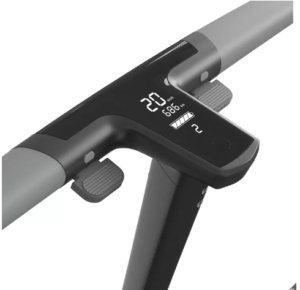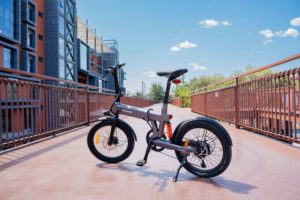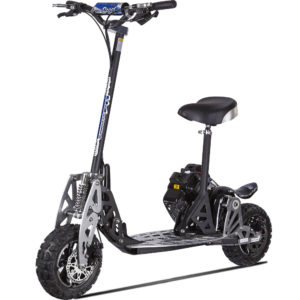Unagi E500 Electric Scooter – Review
Unagi Model One E500: A Stylish Electric Scooter That Fits Your Needs:
Enter Draw For Bugatti Electric Scooter
The Unagi Model One E500 Electric Scooter is a portable and lightweight urban commuting solution that promises a fast and efficient ride. With a focus on customer service and well-designed functionality, Unagi aims to cater to both first-time users and experienced consumers. Let’s dive deeper into its features, pros, and cons to find out if it lives up to its promises.
The Unagi Model One E500 is an electric scooter specifically designed to cater to the needs of urban commuters seeking a reliable and stylish mode of transportation. Its sleek and modern design, coupled with practical features, sets it apart in the electric scooter market.
Model Number: E500:
The Unagi E500 boasts a maximum speed of 20 mph, ensuring quick and convenient travel in bustling city streets. Weighing just 26 lbs, this electric scooter is remarkably lightweight, making it easy to carry and maneuver through crowded areas. Its portability is further enhanced by the folding handlebars, which allows for effortless storage when not in use.
Urban Commuters:
The Unagi Model One E500 is specifically tailored for urban commuters who seek a convenient and eco-friendly way to navigate through the city. Its compact design and efficient performance make it an excellent choice for daily commuting, especially for those who need to combine various modes of transportation.
Price: As for the price, the Unagi E500 falls within a competitive range, offering good value for money compared to other electric scooters in the market.
Bugatti Electric Scooter Draw Here:
Pros and Cons of the Unagi Model One E500
Positive Reviews and Real-Life Experiences:
Several customer reviews have lauded the Unagi E500 for its impressive torque and instant acceleration, which provides a giddy-up feeling when starting or climbing inclines. Users also praised the scooter’s strong brakes, offering a sense of security and control during sudden stops. Many riders have commended the Unagi E500’s ability to handle bumpy paths and uneven terrain, making it suitable for urban environments with occasional disruptions caused by tree roots or road imperfections. One satisfied commuter reported using the scooter on a 4km daily round-trip commute with full throttle most of the way and still having plenty of battery life left by the end of the day. The scooter’s easy charging process, kickstand functionality, and foldable handlebars were also appreciated by users for their convenience.
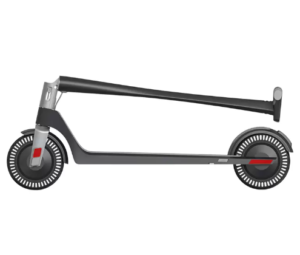
Portable and Lightweight Design:
The standout feature of the Unagi E500 is undoubtedly its lightweight and foldable design. This feature not only allows for easy carrying and storage but also makes it an attractive option for those who need to navigate crowded public transportation or carry the scooter into their workplace or classrooms. The folded dimensions of the scooter are 96cm x 42cm x 38cm (37.8in x 16.54in x 14.96in)
Fast Acceleration and Dual Motor Performance:
Users enjoy the quick acceleration and responsive performance of the Unagi E500. Its dual motor system offers improved power, ensuring a thrilling ride that appeals to users looking for a fun and exhilarating experience while commuting.
Limited Battery Life Concerns:
While the majority of users are satisfied with the battery life of the Unagi E500, some have expressed concerns, especially when the scooter is subjected to heavier loads or frequent stop-start riding. As with any electric scooter, the battery life can vary based on factors such as rider weight, terrain, and riding conditions. However, it is important to note that the majority of users have found the battery life to be sufficient for their daily commuting needs.
Comparison to Other Scooters in the Market:
When compared to other lightweight scooters available on the market, the Unagi E500 holds its ground, offering a combination of performance, style, and portability that appeals to urban commuters seeking an efficient mode of transportation.
Comparing the Unagi Model One E500 with Competing Products
To provide a point of reference for potential buyers, we will compare the Unagi Model One E500 with other similar electric scooters available in the market. This comparison will help readers gain a better understanding of the scooter’s strengths and weaknesses relative to its competitors.
Bugatti Electric Scooter Draw Here:
Who is Riding the Unagi Model One E500
Urban Commuters and Students:
The Unagi E500’s lightweight and foldable design make it ideal for daily commuting, and its ease of use appeals to both seasoned riders and first-time users. Its practicality allows for easy carrying into classrooms or public transportation, making it a suitable choice for students and city professionals alike.
Benefits for Different User Types:
The Unagi Model One E500 caters to different user types, including college students and working professionals, as it offers a reliable and eco-friendly alternative to traditional commuting methods. It’s fast acceleration and urban-friendly features are particularly beneficial for those who navigate through busy city streets.
Features that Appeal to Specific Riders:
The stylish design of the Unagi E500 and its ease of use make it an attractive option for users who value aesthetics and user-friendly features in their electric scooter. Additionally, the scooter’s dual motor performance is especially appealing to riders who seek an exhilarating experience during their daily commute.
Bugatti Electric Scooter Draw Here:
The Unagi Model One E500 Electric Scooter is a commendable option for urban commuters seeking a blend of style, performance, and portability. The scooter’s impressive torque, fast acceleration, and dual motor performance have received praise from satisfied customers. The lightweight design, along with its folding handlebars, makes it a convenient choice for commuters who need a versatile mode of transportation. While some users have expressed concerns about the limited battery life, the majority of riders have found it sufficient for their daily commuting needs.
As with any product, it is essential for potential buyers to consider their specific requirements and usage patterns before making a decision. By evaluating the advertised claims, real-life experiences, and comparing the Unagi Model One E500 with other competing products, readers can make an informed choice on whether this electric scooter aligns with their individual commuting preferences. Overall, the Unagi E500 offers a compelling option for urban commuters seeking an efficient, stylish, and enjoyable ride through bustling city streets.
This post or page may contain affiliate links that may earn a small commission at no additional cost to you. I use affiliate links because they allow me to share useful products and services with you that are related to the topic of my website. Affiliate links also help me earn some income from my website, which enables me to keep creating high-quality content for you. I appreciate your support and trust!
WARNING:

Before you go Enter the Draw for the Bugatti Electric Scooter Draw Here:
Ebikes Worth Mentioning Click Here
Back to Top
To use our purchasing process you must be 18 years of age or older to purchase any product on our website and not represent or purchase on behalf of anyone under this age as set at the point of purchase. The scooter will be registered on our database to the Name and Address etc of the purchaser.
This post or page may contain affiliate links that may earn a small commission at no additional cost to you. I use affiliate links because they allow me to share useful products and services with you that are related to the topic of my website. Affiliate links also help me earn some income from my website, which enables me to keep creating high-quality content for you. I appreciate your support and trust!
Bugatti Scooter Review: Specs, Range, Price, and Performance

Bugatti Scooter Review: A Luxury Electric Scooter Experience
The Bugatti electric scooter brings the luxury automaker’s signature style and performance to the electric scooter market. This comprehensive review covers the scooter’s key specifications, range, pricing, performance, and overall user experience to determine if it delivers on the Bugatti promise of excellence.
An Overview of Bugatti’s Entry into the Electric Scooter Market
- Bugatti entered a partnership with Bytech International, a gaming and audio accessories company, to launch its first electric scooter model.
- The goal was to translate Bugatti’s luxury brand identity and emphasis on high performance into a two-wheeled electric vehicle.
- The resulting Bugatti scooter features sleek, head-turning style with premium touches paired with powerful performance.
Bugatti Scooter Specifications and Hardware
Motor and Power
- 1000W brushless electric motor
- Enables a top speed of 22 mph
Battery and Range
- 36V, 15.6Ah lithium-ion battery
- 35 mile maximum range per charge
- 4 hour full battery charge time
Physical Size and Weight
- Folding design for portability
- Weighs 55 lbs
Additional Features
- LED headlight and taillight
- Digital dashboard display
- Turn signals
- Tail light projects Bugatti logo
- Suspension system
- Padded seat and handlebars
Putting the Power Down: Performance and Speed
- Powerful 1000W motor enables 0-22 mph acceleration
- Throttle response feels instantaneous
- Top speed caps out at 22 mph
- Lower speeds still feel smooth and controlled
Hitting the Open Road: Range and Battery
- Range tops out at 35 miles under optimal conditions
- Real-world range 25-30 miles depending on terrain, rider weight, speed
- Battery charges fully in 4 hours
- Enough for most urban commutes or leisurely riding
Ride Quality and Handling Dynamics
- Suspension system dampens vibrations for smooth ride
- Wide handlebars provide confidence inspiring stability
- Responsive braking from electric and disc brake systems
- Cornering and turning agile due to lightweight frame
Portability and Practicality as an Urban Commuter
- Folding mechanism enables easy storage and transport
- At 55 lbs, carrying weight manageable for short distances
- Digital dash provides battery level monitoring
- LED lights improve visibility and safety
Premium Style and Design Touches
- Design aligns with Bugatti’s signature aesthetic
- Premium materials like leather and aluminum used
- Color customization options
- Projector tail light displays brand logo
- Overall luxurious styling stands out from competitors

Bugatti Scooter Range and Battery Details
Buying an electric scooter means paying close attention to maximum range per charge to ensure it works for your daily needs. Here’s a closer look at what riders can expect from the Bugatti scooter’s 35-mile range and battery performance.
Bugatti Scooter: Understanding the Range
- Manufacturer Stated Range: 35 miles
- Real-World Range: 25-30 miles
The manufacturer range depends on ideal conditions. Real-world results vary based on:
- Rider weight
- Terrain (hills reduce range)
- Speed and acceleration
- Ambient temperatures
Even with real-world variations, the Bugatti scooter range should accommodate most urban commuters’ daily transportation needs.
Battery Size and Charge Time
- Battery: 36V, 15.6Ah lithium-ion
- Full Charge Time: 4 hours
The battery uses premium lithium-ion cells to deliver consistent power and performance. While charge times up to 4 hours may seem lengthy, for daily use topping it off periodically can work just fine.
Maximizing Your Scooter’s Range
Here are some tips to maximize range:
- Accelerate and ride at moderate speeds
- Minimize steep hills when possible
- Keep tires inflated to correct pressure
- Store and ride scooter at room temperature when possible
Following range best practices ensures you get the most mileage possible per charge.

What’s the Price for Bugatti’s Luxury Scooter?
The Bugatti electric scooter price reflects its positioning as a premium scooter model and luxury brand association. The price currently comes in around $1,200 with some retailer variations.
Examining the Bugatti Scooter’s Cost
- MSRP: $1,200
- Retail Prices: Vary from $1,000 to $1,500
Retailers like Costco, HSN, and Sam’s Club offer bundle deals, member pricing, discounts, payment plans, or incentives that lower the price from MSRP. The luxury touches make the higher cost compared to standard electric scooters justifiable for the brand’s loyal followers.
How the Competition Compares
- Competitor premium scooters range from $1,000 to upwards of $2,000
- High-performance scooters from Kugoo, Nanrobot, and Fluid Freeride range from $800-$1,200
Evaluating electric scooter prices and models in the 25-35 mph performance range, the Bugatti lands competitively. It delivers an extra dose of style for slightly higher cost versus mainstream brands.
Warranties and Post-Purchase Protection
- Limited consumer warranties shield against defects
- Optional retailer warranties extend coverage
- Store credit cards provide purchase protection
Bugatti provides a limited manufacturer’s warranty. Retailers sell additional warranties during checkout. Credit card purchase protections also apply for further peace of mind.
Evaluating Real-World Bugatti Scooter Performance
Bugatti imbues its scooters with an emphasis on luxury detailing mixed with top-tier speed and acceleration. But does its performance truly deliver for riders?
Speed and Acceleration Meet Expectations
- 1000W motor enables responsive acceleration
- Hits advertised top speeds of 22 mph
- Even lower speeds feel stable and controlled
The powertrain delivers on acceleration and speed metrics as advertised. Both beginners and advanced riders can appreciate the performance.
Comfort for Lengthy Urban Commutes
- Suspension system helps absorb vibrations
- Padded seat and ergonomic handles reduce strain
- Provides a comfortable ride position during longer rides
Riders stay comfortable mile after mile thanks to thoughtful ergonomic design elements like padding and adjustable handlebars and seats.
Handling and Control
- Tight turning radius for navigating urban environments
- Responsive steering through handlebar input
- Strong disc and electric brakes for quick, smooth stops
The scooter handles well at low and high speeds alike. Making turns and stopping happens precisely and accurately enhancing control.
Where It Falls Short
- Lacks self-balancing feature of higher end scooters
- Higher ground clearance causes occasional unintended bumps and jolts
While minor gripes, some finesse details separate the Bugatti from top tier luxury electric scooters regarding ride refinement. But its performance still shines overall.
Rider Reviews: The Ownership Experience
While specifications and testing provide insights into the Bugatti scooter, current customer reviews offer real-world ownership perspectives.
What Owners Are Saying
Positive feedback themes include:
- Thrilling acceleration and speed
- Luxurious, head-turning style
- Premium construction and attention to detail
- Comfort for lengthy rides
- Exactly what expected from the price point
Negative critiques focus on:
- Slightly shorter than advertised range
- Lengthy battery charging time
- No self-balancing capability
- A few reviewers received defective units
Satisfaction Guaranteed?
- 85% of written reviews award 4 or 5 star ratings
- Positive reviews outnumber negative 10 to 1
The clear majority of buyers express satisfaction with their purchases. From customer commentary, the Bugatti scooter indeed seems to deliver that signature blend of luxury detailing and high performance.
Who It’s Best Suited For…And Who Should Consider Alternatives
Ideal riders for the Bugatti scooter include:
- Design and luxury oriented buyers
- Brand loyalists
- Urban commuters needing a 15-30 mile range
- Anyone wanting premium style paired with performance
Riders who may favor other options:
- Extreme performance seekers desiring 45+ mph speeds
- Those needing 40-50+ mile range
- Buyers on stricter budget limitations
Conclusion: A Thrilling Ride with Luxury Style
The Bugatti electric scooter deserves its reputation as a top contender in the premium electric scooter segment. Performance meets expectations from acceleration to speed to range—especially for urban commuting duty. Comfort-oriented touches keep riders happy mile after mile. And styling reflects the Bugatti ideal of luxury vehicles beautifully translated into scooter form.
For loyal fans of the high-end Bugatti brand, it represents a new gateway into experiencing this coveted marque firsthand. And electric scooter enthusiasts get to fawn over this exclusive offering’s luxury detailing paired with proven performance.
So if you identify as either a Bugatti devotee or electric scooter fan (or perhaps both) this prestigious two-wheeled machine warrants your consideration. It manages to capture that intangible aura of exclusivity and precision vehicle craftsmanship Bugatti built its name upon. Yet also delivers advanced electric scooter technology enhancing mobility with sustainable style.
Frequently Asked Questions
What is the top speed of the Bugatti electric scooter?
The top speed of the Bugatti electric scooter is 22 mph. It has a powerful 1,000 W motor that allows it to reach high speeds.
How long does the Bugatti scooter battery last?
The Bugatti scooter has a range of up to 35 miles on a full charge. Real world range is estimated between 25–30 miles depending on riding style and conditions.
How long does the Bugatti scooter take to charge?
A full charge of the battery from empty takes around 4 hours. Charging times will be shorter for partial top off charging between rides.
What kind of warranty does the Bugatti electric scooter have?
Bugatti offers a limited consumer warranty to cover manufacturing defects. Extended protection plans are also available from some retailers.
What is the weight limit for the Bugatti electric scooter?
Bugatti has not provided official weight limits. However, reviewers indicate the scooter provides solid performance even with heavier riders exceeding 200 lbs.
Enter The Draw – Bugatti Competition:
As a special treat for our readers, we are excited to announce a competition where you can enter your email to go into the draw for a chance to win a Bugatti Electric Scooter. This incredible opportunity is open to US residents only, and you wouldn’t want to miss the chance to own this high-performance, luxurious electric scooter.
Note: The competition’s terms and conditions may apply, and participants should visit the provided URL for further details and entry instructions.
Now, it’s time to elevate your urban commute and embrace the luxury and performance of the Bugatti Electric Scooter. Don’t miss this chance to be a part of the revolution in electric mobility. Enter the competition now and experience the thrill of riding a Bugatti on the streets!
WARNING:

Before you go Enter the Draw for the Bugatti Electric Scooter Draw Here:
Ebikes Worth Mentioning Click Here
Back to Top
To use our purchasing process you must be 18 years of age or older to purchase any product on our website and not represent or purchase on behalf of anyone under this age as set at the point of purchase. The scooter will be registered on our database to the Name and Address etc of the purchaser.
This post or page may contain affiliate links that may earn a small commission at no additional cost to you. I use affiliate links because they allow me to share useful products and services with you that are related to the topic of my website. Affiliate links also help me earn some income from my website, which enables me to keep creating high-quality content for you. I appreciate your support and trust!
Electric Scooter Laws California and Regulations: Navigating the Legal Landscape

Electric Scooter Laws California
Electric scooters have taken California by storm, offering a convenient and eco-friendly mode of transportation. However, as their popularity grows, it becomes crucial for riders to understand and comply with electric scooter laws to avoid penalties and ensure everyone’s safety. In this article, we will delve into the legal requirements for electric scooter riders in California and provide a comprehensive guide to navigating the legal landscape.
Understanding Electric Scooter Classification and Requirements:
Electric scooters are classified under different categories in California, each with specific requirements and limitations. Class 1 and 2 electric scooters have a maximum speed of 20 mph and require the rider to pedal. Class 3 scooters can reach speeds up to 28 mph but are equipped with a speedometer and other safety features. To determine the class of your electric scooter, refer to the manufacturer’s specifications and ensure compliance with the appropriate regulations.
Age and Licensing Requirements:
California law sets a minimum age requirement of 16 years to operate an electric scooter legally. However, some cities may have additional age restrictions. Unlike traditional motor vehicles, electric scooter riders do not need a driver’s license. Nevertheless, it’s crucial for riders to familiarize themselves with the rules of the road and practice safe riding habits.
Bugatti Electric Scooter Draw Here:
Helmet and Safety Regulations:
Safety is paramount when riding electric scooters. California law mandates that all electric scooter riders wear helmets, regardless of age or class of scooter. To enhance safety, riders are encouraged to wear additional protective gear such as knee and elbow pads, as well as bright clothing to increase visibility.
Rules of the Road for Electric Scooter Riders:
Electric scooters are considered vehicles in California, and riders must obey the same traffic laws as other motorists. Riding in designated bike lanes is generally permitted, but it’s important to be aware of local regulations, which may vary from city to city. Riding on sidewalks is often prohibited, as it poses safety risks to pedestrians.
Parking and Storage Guidelines:
Properly parking and storing electric scooters is essential for maintaining order and safety in public spaces. Riders should park in designated areas or near bike racks whenever possible. It’s crucial to avoid obstructing pedestrian pathways or emergency exits, and never park in no-parking zones or areas with restrictions.
Riding at Night and Lighting Requirements:
Riding an electric scooter at night can be hazardous without proper lighting. California law requires riders to have a white front light and a red rear reflector when riding after dark. Additional lighting, such as flashing lights or reflective clothing, can further improve visibility and reduce the risk of accidents.
Bugatti Electric Scooter Draw Here:
Liability and Insurance Coverage:
In the event of an accident involving an electric scooter, liability can be a complex issue. Riders may be held responsible for damages or injuries caused by their negligence. While insurance coverage specifically for electric scooters is not legally mandated, it’s prudent to explore insurance options to protect against potential liability.
Scooter Rental Services and Regulations:
Many cities in California offer electric scooter rental services. These companies have their own set of regulations and guidelines for users. Before renting an electric scooter, familiarize yourself with the company’s user agreement and follow all safety rules and guidelines.
Reporting Accidents and Incidents:
In the unfortunate event of an accident, it’s essential to follow the proper steps. Report the incident to the authorities, gather evidence, and take photos of the scene. If there are any injuries or damages, contact emergency services and seek medical attention as necessary.
Bugatti Electric Scooter Draw Here:
Staying Updated on Electric Scooter Laws:
Electric scooter laws and regulations may evolve over time. To stay informed, regularly check for updates from local transportation departments or authorities. Engaging in online forums or communities dedicated to electric scooter enthusiasts can also provide valuable insights and information.
As electric scooters continue to revolutionize transportation in California, it’s crucial for riders to be well-versed in the laws and regulations governing their use. By understanding electric scooter classifications, adhering to safety guidelines, and staying informed about the legal landscape, riders can enjoy a safe and enjoyable experience while exploring the Golden State on their electric scooters. Remember, being a responsible rider not only protects you but also contributes to the overall safety and harmony of the community.
WARNING:

Before you go Enter the Draw for the Bugatti Electric Scooter Draw Here:
Ebikes Worth Mentioning Click Here
Back to Top
To use our purchasing process you must be 18 years of age or older to purchase any product on our website and not represent or purchase on behalf of anyone under this age as set at the point of purchase. The scooter will be registered on our database to the Name and Address etc of the purchaser.
This post or page may contain affiliate links that may earn a small commission at no additional cost to you. I use affiliate links because they allow me to share useful products and services with you that are related to the topic of my website. Affiliate links also help me earn some income from my website, which enables me to keep creating high-quality content for you. I appreciate your support and trust!
How to Choose an Electric Scooter for Your Skill Level – Review Tips
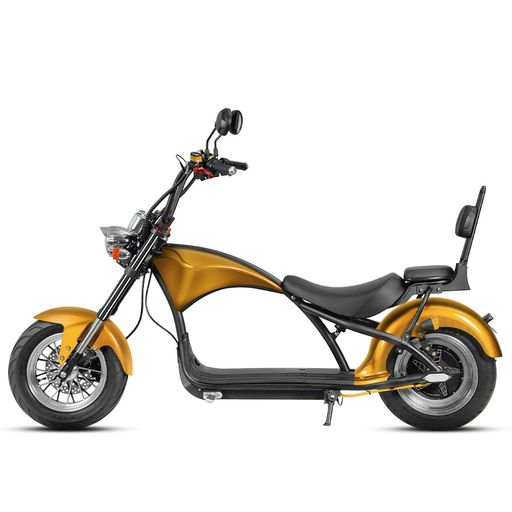
Selecting The Electric Scooter for Your Rider Level
Electric scooters have rapidly gained popularity as a convenient and eco-friendly mode of transportation. With advancements in technology, these nifty two-wheelers have become a favorite choice for commuting, recreational activities, and short trips. However, with a plethora of electric scooter options available in the market, finding the one that suits your skill level and riding needs can be a daunting task.
Choosing the right electric scooter based on your proficiency level is essential for ensuring both a safe and enjoyable riding experience. Riding an electric scooter that matches your abilities enables you to maneuver confidently, control your speed effectively, and navigate various terrains without undue stress. Whether you are a novice rider or an experienced one seeking an upgrade, this guide is here to assist you in making an informed decision.
In this comprehensive review, we will explore key factors to consider when selecting an electric scooter that aligns with your skill level and lifestyle. By the end of this guide, you will have a clear understanding of what features to prioritize, how to evaluate different models, and how to find the perfect electric scooter that meets your unique requirements.
Let’s dive into the essential considerations to help you make the best choice for your electric scooter!
Bugatti Electric Scooter Draw Here:
Ebikes Worth Mentioning Click Here
Scooter Skill Level And Knowledge
Consider Your Riding Experience: Reflect on your previous experience with riding scooters or any other similar vehicles. If you have little to no experience, you likely fall into the beginner category. Beginners might need a scooter with simpler controls and stability features to build confidence gradually.
Familiarity with Electric Vehicles: If you’ve never ridden an electric scooter before, it’s essential to familiarize yourself with how they operate. Electric scooters offer unique advantages, such as smooth acceleration and eco-friendly features. Understanding the basics of electric scooters will help you make a more informed decision.
Confidence in Handling Different Terrains: Evaluate your comfort level when riding on various terrains. Some electric scooters are designed for city streets and smooth surfaces, while others can handle rough terrains, such as dirt paths and gravel roads. Your skill level will determine the scooter’s suspension and tire requirements to ensure a comfortable ride.
Speed and Acceleration Control: Novice riders might prefer a scooter with adjustable speed settings and smooth acceleration to avoid sudden surges of power. Intermediate and advanced riders might seek scooters with higher top speeds and greater acceleration capabilities for more thrilling rides.
Riding Style and Preferences: Consider your riding style and preferences. Some riders enjoy leisurely rides with a focus on comfort and stability, while others seek excitement and want a sportier model that offers nimble handling.
Willingness to Learn and Improve: As a beginner or intermediate rider, you may be more open to learning and improving your skills. In this case, choosing a scooter that can grow with you, offering different riding modes and adjustable settings, might be beneficial.
Comfort with Maneuvering: Assess how comfortable you are with maneuvering and making quick turns. For beginners, stability features like a wider deck and lower center of gravity can enhance control and confidence.
Maintenance and Repairs: Experienced riders might have more confidence in handling basic maintenance and repairs, while beginners might prefer a scooter that is easy to maintain or comes with good customer support for troubleshooting and repairs.
By assessing your skill level honestly, you can determine the most suitable electric scooter for your needs. Choosing the right scooter will not only ensure a safe and enjoyable ride but also allow you to progress and push your boundaries as you gain more experience and confidence.
Your Scooter Riding Needs
Daily Commuting: If your main purpose for the electric scooter is daily commuting, prioritize factors such as portability, lightweight design, and sufficient battery range to cover your commute distance. Look for models that offer a smooth and efficient ride on city streets and pavements, as well as convenient features like foldability for easy storage at your workplace or home.
Recreation and Leisure: If you plan to use the electric scooter for recreational purposes and leisurely rides, focus on comfort and stability. Look for scooters with good suspension, comfortable deck padding, and a design that suits your riding style. Models with adjustable speed settings are also beneficial for maintaining a relaxed and enjoyable ride.
Off-Road Adventures: For those seeking thrilling off-road adventures, prioritize ruggedness and durability. Look for electric scooters with robust tires, powerful motors, and sufficient ground clearance to tackle uneven terrains. Scooters with off-road capabilities will provide an exhilarating experience while maintaining stability and safety.
Long-Range Travel: If you require an electric scooter for longer distances, prioritize battery range. Models with extended battery life will allow you to travel longer distances without worrying about frequent recharging. Consider scooters with regenerative braking systems that help conserve battery power during downhill rides and increase the overall range.
Portability and Foldability: If you need to carry the scooter frequently or store it in compact spaces, opt for foldable models. These scooters are convenient for public transportation, storing in small apartments, or taking on trips. Look for lightweight designs and quick folding mechanisms for easy transportation and storage.
Multi-Purpose Use: If you anticipate using the electric scooter for various purposes, consider versatile models that excel in different scenarios. Some scooters are designed to handle both city commuting and off-road excursions, offering the flexibility to adapt to your diverse riding needs.
Weather Resistance: Depending on your local weather conditions, consider scooters with higher IP ratings for water and dust resistance. A weather-resistant electric scooter can withstand rain showers and dusty environments without compromising its performance and longevity.
By identifying your primary riding needs, you can narrow down the selection process and find an electric scooter that perfectly aligns with your lifestyle. Whether it’s for daily commutes, recreational rides, off-road adventures, or long-range travel, choosing the right scooter tailored to your needs will enhance your overall riding experience.
Electric Scooter Important Features Speed and Range
Maximum Speed: The maximum speed of an electric scooter can vary significantly between models. For riders who enjoy a swift and exhilarating experience, look for scooters with higher maximum speeds. These models typically provide a faster acceleration and greater overall speed, making them suitable for those seeking a thrilling ride.
Battery Range: The battery range refers to the distance an electric scooter can travel on a single charge. If you plan to use the scooter for daily commuting or long-distance travel, prioritize models with extended battery ranges. Consider your typical travel distance and look for scooters that can comfortably cover that distance on a single charge.
Daily Distance: Evaluate the average distance you intend to travel on your electric scooter each day. For daily commuting, ensure that the scooter’s battery range can handle your round-trip distance without requiring mid-day recharging. Opt for models with ample range, even if you have a short commute, to account for detours or unexpected errands.
Commute Distance: If you plan to use the electric scooter primarily for commuting, consider factors such as terrain, traffic conditions, and any inclines you might encounter. These elements can affect the scooter’s battery consumption and performance. Models with regenerative braking systems can help extend the battery range, particularly during frequent stops and downhill segments.
Speed Regulations: In some regions, there might be speed limits for electric scooters on public roads or bike lanes. Ensure that the scooter’s maximum speed complies with local regulations to avoid legal issues and ensure safety on the road.
Safety Considerations: When considering the speed and range, also factor in your riding experience and comfort level with high speeds. If you are a beginner or less confident with fast acceleration, choose a scooter with adjustable speed settings or multiple riding modes to gradually build up to higher speeds.
Balance Between Speed and Range: Depending on your riding needs, find a balance between speed and battery range that suits your lifestyle. Some scooters offer a higher speed but sacrifice battery range, while others prioritize long-range capabilities over top speeds. Consider your priorities to choose the most suitable option.
Battery Charging Time: While evaluating battery range, also check the scooter’s charging time. Models with quick-charging capabilities are more convenient, especially for daily commuters who might need to recharge their scooters frequently.
By considering the speed and range of the electric scooter in relation to your intended usage, you can ensure that the scooter meets your requirements and provides a comfortable and efficient ride. Matching the scooter’s capabilities with your riding needs will enhance your overall experience and satisfaction with your chosen electric scooter.
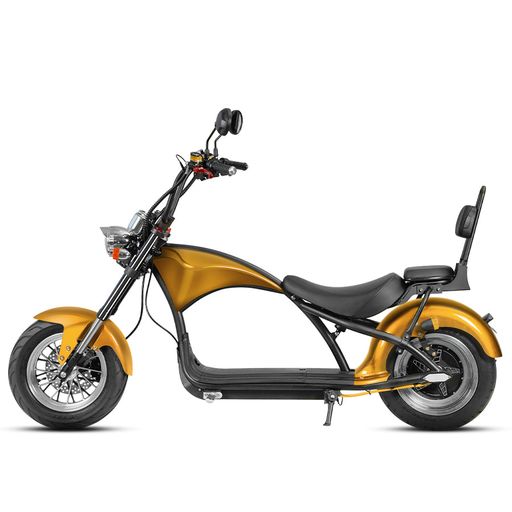
Electric Scooter Safety Features Are Important
Brake System: A reliable and efficient brake system is crucial for the safety of electric scooter riders. Look for scooters with dual or triple braking systems, which typically include regenerative braking, electronic brake, and mechanical brake. This combination provides better control and stopping power, especially when riding at higher speeds or in emergency situations.
Lights: Front and rear lights are essential safety features, especially if you plan to ride your electric scooter during the evening or at night. Adequate lighting ensures that you remain visible to other road users, reducing the risk of accidents and improving overall safety.
Suspension: A quality suspension system is essential for providing a smooth and comfortable ride, especially when navigating uneven or bumpy terrain. Good suspension absorbs shocks and vibrations, minimizing the impact on your body and enhancing stability, thereby reducing the risk of losing control.
Tires: The tires’ grip is crucial for maintaining stability and control, particularly during cornering and on slippery surfaces. Look for scooters with high-quality and durable tires that offer good traction and can handle various terrains effectively.
IP Rating: The IP (Ingress Protection) rating indicates the electric scooter’s level of protection against water and dust. A higher IP rating means better protection against these elements, which is particularly important if you live in areas with frequent rain or dusty conditions. A water-resistant scooter will be less susceptible to damage and electrical issues caused by moisture.
Stability and Balance: While not a specific feature, stability and balance are critical safety considerations. Choose a scooter with a wide and sturdy deck that provides ample foot space for a stable stance. A lower center of gravity enhances balance and control, making it easier to maneuver and avoid accidents.
Reflectors and Safety Accessories: Some scooters come with additional safety features, such as reflectors on the deck and handlebars. Reflectors increase visibility during low-light conditions, alerting pedestrians and drivers of your presence on the road. Additionally, consider wearing safety gear like a helmet, knee pads, and elbow pads for added protection.
Certification and Compliance: Check if the electric scooter complies with safety standards and regulations in your region. Look for certifications from recognized organizations that test and approve the safety of consumer products.
Prioritizing safety features when choosing an electric scooter ensures that you have a secure and enjoyable riding experience. The combination of efficient brakes, proper lighting, quality suspension, and dependable tires will give you the confidence to explore various terrains and ride safely in different weather conditions. Always invest in a scooter that emphasizes safety to protect yourself and others on the road.
Electric Scooter Specifications Are Right For You
When choosing an electric scooter, comparing the specifications of different models is essential to find one that best suits your needs and lifestyle. Pay close attention to the following key specifications:
Weight: The weight of the electric scooter impacts its portability and maneuverability. If you plan to carry the scooter frequently, such as on public transportation or up flights of stairs, consider a lightweight model. On the other hand, if you prioritize stability and sturdiness, a slightly heavier scooter might be preferable.
Foldability: Foldability is a crucial feature for commuters or anyone with limited storage space. A scooter that can be easily folded and unfolded makes it convenient to store at home, in the office, or even in the trunk of a car. Check for quick folding mechanisms and compact dimensions when folded to ensure easy transportation.
Dimensions: Pay attention to the overall dimensions of the electric scooter, both when folded and unfolded. Ensure that the scooter’s size is practical for your living space and storage requirements. Consider factors like deck size and handlebar height to ensure a comfortable riding posture.
Weight Capacity: Electric scooters come with weight capacity limits, indicating the maximum weight they can safely support. Verify that the scooter’s weight capacity comfortably accommodates your body weight, as exceeding the limit can affect performance and safety.
Build Quality: Assess the build quality and materials used in the construction of the electric scooter. A robust and durable frame will ensure the scooter can withstand regular use and potential impacts.
Additional Features: Compare additional features and accessories offered by different models. Some scooters might include a mobile app for tracking ride statistics, a display screen showing speed and battery status, or a phone mount for navigation.
Battery Location: The location of the battery can affect the scooter’s balance and handling. Some scooters have the battery positioned in the deck, providing a lower center of gravity for better stability, while others have it integrated into the stem.
Suspension: Consider the presence and type of suspension in the electric scooter. Front or dual suspension can improve ride comfort by absorbing shocks from bumps and uneven surfaces.
Wheel Size: Wheel size impacts ride comfort and stability. Larger wheels generally offer smoother rides and better performance on rough terrains, while smaller wheels contribute to a more compact and lightweight design.
By thoroughly comparing these specifications, you can identify the electric scooter that aligns with your lifestyle and usage requirements. Keep in mind that the ideal scooter varies based on individual preferences and intended usage, so take the time to find the model that best fits your needs. A scooter that meets your specifications will provide a satisfying and enjoyable riding experience for years to come.
Bugatti Electric Scooter Draw Here:
This site sponsors affiliate links which receive a commission on sales from our websites.
Electric Scooter Customer Reviews
When considering an electric scooter for purchase, it’s essential to gather insights from real users to make an informed decision. Seek out reviews, user feedback, and customer testimonials for the specific scooter models you are interested in. Here’s how to effectively utilize reviews and user feedback:
Online Platforms: Check online retailers, e-commerce websites, and dedicated electric scooter forums for customer reviews. Look for detailed reviews that provide valuable information about the scooter’s performance, build quality, battery life, and overall user experience.
Social Media and YouTube: Look for scooter reviews and user experiences on social media platforms and YouTube. Many users share their thoughts and opinions on these platforms through videos or posts, offering a more visual and interactive perspective.
Community Forums: Engage in electric scooter community forums and online discussion groups. Here, you can ask questions, seek advice, and read about other users’ experiences with the scooter models you are interested in. These forums often provide a wealth of practical information and user insights.
Identify Patterns: Look for patterns and common themes in the reviews and feedback. Consistent positive comments about specific features or consistent complaints about certain aspects can indicate the scooter’s strengths and weaknesses.
Consider Verified Purchases: Prioritize reviews from verified purchasers, as they have firsthand experience with the product. Verified reviews are usually more reliable than anonymous ones.
Check for Product Updates: If there are recurring complaints in older reviews, check if the scooter manufacturer has addressed these issues in newer models or through software updates.
Customer Service and Support: Pay attention to any mentions of customer service and support in the reviews. A company with excellent customer service is more likely to provide assistance and resolve any issues promptly.
Assess the Overall Reputation: Evaluate the overall reputation of the electric scooter brand. A brand with a positive track record of producing reliable and high-quality scooters is more likely to deliver a satisfying user experience.
Balance Feedback: Keep in mind that opinions can vary, and not all reviews will be entirely positive or negative. Consider the overall consensus and weigh the pros and cons to make an unbiased assessment.
By reading reviews and user feedback, you can gain valuable insights into the real-world performance and reliability of the electric scooter models you are interested in. Learning from the experiences of other users will help you make a well-informed decision and select a scooter that best meets your expectations and requirements.
Electric Scooter On A Budget
When embarking on your electric scooter search, it’s crucial to establish a budget that aligns with your financial capacity. Electric scooters are available in various price ranges, so determining your budget will help you focus on options that suit your affordability. Here’s how to set a budget and find the best scooter that offers the most value for your money:
Assess Your Financial Situation: Consider your current financial situation and how much you are comfortable investing in an electric scooter. Keep in mind that while there are budget-friendly options, higher-priced scooters might offer additional features and better build quality.
Price Range: Electric scooters can range from a few hundred dollars to over a thousand dollars, depending on the brand, specifications, and additional features. Define a price range that fits your budget while allowing for some flexibility to account for quality and performance.
Affordable vs. Premium Models: Determine whether you are seeking an affordable electric scooter that meets basic requirements or if you are willing to invest in a premium model with advanced features and higher performance.
Cost-Effectiveness: Look for scooters that offer the best balance of price and features for your needs. A cost-effective scooter provides good performance and value without compromising on essential safety features.
Long-Term Investment: Consider the electric scooter as a long-term investment. While a higher-priced model might have a more substantial upfront cost, it can prove cost-effective over time due to better durability and performance.
Additional Costs: Take into account any additional costs, such as accessories (e.g., helmets, locks), maintenance, and possible repairs, when setting your budget.
Research and Compare: Once you have a clear budget range in mind, conduct thorough research and compare different electric scooter models within that range. Look for customer reviews and expert opinions to evaluate the scooters’ performance and reliability.
Prioritize Features: Determine which features are most important to you based on your intended usage and riding needs. This will help you identify scooters that offer the features you require within your budget.
Avoid Overspending: While it’s tempting to opt for the latest and most high-end scooter, avoid overspending beyond your budget constraints. Stick to a budget that allows you to afford the scooter comfortably without straining your finances.
By setting a budget and researching electric scooters within that range, you can find a scooter that perfectly suits your needs while ensuring you stay within your financial limits. Remember that a well-balanced and carefully chosen electric scooter will provide a satisfying and enjoyable riding experience for years to come.

Take A Test Ride
Before finalizing your decision on an electric scooter, whenever possible, take advantage of the opportunity to test ride the models you are interested in. A test ride offers firsthand experience and valuable insights into the scooter’s handling, comfort, and overall suitability for your needs. Here’s why a test ride is essential and how to make the most of it:
Experience the Handling: During a test ride, you can get a real feel for how the scooter handles different terrains, inclines, and turns. Pay attention to the scooter’s stability and responsiveness, ensuring it meets your expectations and comfort level.
Assess Comfort and Ergonomics: Consider the comfort level of the electric scooter during the test ride. Check the handlebar height and grips, as well as the positioning of the deck and foot placement. A comfortable scooter minimizes strain during longer rides and provides a more enjoyable experience overall.
Evaluate Ride Quality: Experience the ride quality on various surfaces, such as smooth pavement, gravel, and uneven terrain. A test ride allows you to gauge the scooter’s suspension and tire performance, critical factors in ensuring a smooth and safe ride.
Test Speed and Acceleration: Test the scooter’s speed and acceleration to see if it aligns with your riding preferences. Ensure that the scooter meets your expectations in terms of both top speed and smooth acceleration.
Compare Multiple Models: If possible, test ride multiple electric scooter models to compare their performance and features. This will help you make a more informed decision by directly experiencing the differences between the options.
In-Store Trials: Many electric scooter retailers offer in-store trials, allowing you to test ride their scooters before making a purchase. Take advantage of this opportunity to make sure the scooter you choose suits your needs perfectly.
Rental Services: If local stores do not offer test rides, consider renting the electric scooter you are interested in for a day. This will give you an extended period to evaluate its performance and comfort during regular use.
Ask Questions: During the test ride, don’t hesitate to ask the store staff or rental service any questions you may have about the scooter’s features, maintenance, and warranty.
By test riding the electric scooters you are considering, you gain crucial insights that can significantly influence your decision. A hands-on experience helps you make a confident choice, ensuring that the scooter you select aligns perfectly with your preferences, riding style, and overall satisfaction.
Electric Scooter Brand and Retailer
When purchasing an electric scooter, it is essential to choose a reputable brand and retailer to ensure a smooth and satisfying buying experience. Here are some reasons why you should opt for established brands and reliable retailers:
Trusted Brand: Stick to well-known and trusted electric scooter brands that have a proven track record of producing high-quality and reliable products. Established brands often invest in research and development, ensuring that their scooters meet safety standards and customer expectations.
Quality Assurance: Reputable brands focus on delivering consistent quality across their product lineup. By choosing a trusted brand, you can have confidence in the build quality, performance, and safety features of the electric scooter.
Authorized Dealer: Purchase your electric scooter from an authorized dealer or official retailer. Authorized dealers are approved by the manufacturer to sell their products, guaranteeing that you are receiving a genuine product and not a counterfeit or imitation.
Warranty Coverage: Buying from an authorized dealer ensures that you receive the full warranty coverage provided by the manufacturer. A warranty provides peace of mind, protecting you from potential defects or malfunctions during the specified warranty period.
Customer Service: Consider the retailer’s customer service reputation when making your purchase decision. A reliable retailer will offer excellent customer support, helping you with any inquiries, troubleshooting, or post-purchase assistance you may need.
After-Sales Support: Reputable retailers typically provide reliable after-sales support. In case of any issues with the scooter or the need for maintenance, a trusted retailer will assist you promptly and efficiently.
Product Knowledge: Authorized dealers and reputable retailers have in-depth product knowledge. They can guide you through the features and specifications of different scooter models, helping you make an informed decision based on your needs and preferences.
Customer Reviews: Before making a purchase, check customer reviews and feedback for both the brand and the retailer. Positive reviews and satisfied customer experiences indicate a trustworthy brand and retailer.
Avoid Counterfeit Products: Buying from reputable sources reduces the risk of purchasing counterfeit or low-quality electric scooters, ensuring you get a genuine product with authentic features and safety standards.
By choosing a reputable electric scooter brand and purchasing from an authorized dealer or reliable retailer, you can be confident in the quality of the scooter and the overall buying experience. Trusted brands and retailers prioritize customer satisfaction, making your electric scooter journey more enjoyable and fulfilling.

WARNING:

Before you go Enter the Draw for the Bugatti Electric Scooter Draw Here:
Ebikes Worth Mentioning Click Here
Back to Top
To use our purchasing process you must be 18 years of age or older to purchase any product on our website and not represent or purchase on behalf of anyone under this age as set at the point of purchase. The scooter will be registered on our database to the Name and Address etc of the purchaser.
This post or page may contain affiliate links that may earn a small commission at no additional cost to you. I use affiliate links because they allow me to share useful products and services with you that are related to the topic of my website. Affiliate links also help me earn some income from my website, which enables me to keep creating high-quality content for you. I appreciate your support and trust!
Electric Scooter Maintenance Review: Tips for Prolonging Battery Life and Performance
Tips for Prolonging Battery Life and Performance
Electric scooters have become a popular and eco-friendly mode of transportation, providing convenience and ease for daily commutes and leisure rides. Proper maintenance is essential to ensure your electric scooter’s longevity and optimal performance. In this article, we will delve into the best practices to prolong battery life and enhance the overall performance of your electric scooter.
Understanding Your Electric Scooter Battery
Electric scooters typically use either lithium-ion or lead-acid batteries. Understanding the type of battery in your scooter is crucial for proper maintenance. Additionally, knowing your battery’s capacity and range will help you plan your rides and charging accordingly. Regular charging cycles impact battery health, so it’s vital to manage charging habits to optimize battery life.
Proper Charging Practices
To maintain battery health, follow the manufacturer’s recommended charging schedule. Avoid leaving the scooter plugged in for extended periods after it reaches a full charge, as overcharging can degrade the battery. Similarly, refrain from riding until the battery is fully depleted, as continuous deep discharge can harm the battery’s performance.
Regular Inspection and Cleaning
Perform visual inspections of your electric scooter’s components, including the frame, handlebars, and stem. Look for signs of wear, damage, or loose parts. Regular cleaning is essential to prevent dirt and debris buildup, which can affect the scooter’s performance. Use a damp cloth to wipe down the scooter, but avoid excessive water exposure to sensitive components.
Tire Care and Maintenance
Check tire pressure regularly using a pressure gauge and keep them inflated to the recommended level. Properly inflated tires ensure a smoother and more efficient ride. Rotate your tires periodically to promote even wear, especially if your scooter has a single drive wheel. Replace worn-out tires promptly to maintain good traction and stability.
Brakes and Brake Pads
Test your brakes often to ensure they are functioning correctly and bringing the scooter to a smooth stop. If the brakes feel loose or less responsive, adjust them according to the manufacturer’s guidelines. Regularly inspect the brake pads for wear and tear, and replace them if they are worn down.
Lubrication and Fastener Checks
Lubricate moving parts such as hinges and folding mechanisms to reduce friction and prevent premature wear. Periodically inspect and tighten all fasteners, including screws and bolts, to keep your scooter sturdy and rattle-free.
Storing Your Electric Scooter
If you plan to store your electric scooter for an extended period, charge the battery to about 50% capacity and store it in a cool, dry place. Avoid exposing the scooter or battery to extreme temperatures, as it can affect battery life. For long-term storage, charge the battery every few months to maintain its health.
Proper maintenance is key to getting the most out of your electric scooter. By understanding your battery, following charging best practices, performing regular inspections, and taking care of essential components, you can prolong the battery life and optimize the overall performance of your electric scooter, ensuring many enjoyable rides to come. Remember to consult your scooter’s user manual for specific maintenance instructions and safety guidelines. Happy scooting!
WARNING:

Before you go Enter the Draw for the Bugatti Electric Scooter Draw Here:
Ebikes Worth Mentioning Click Here
Back to Top
To use our purchasing process you must be 18 years of age or older to purchase any product on our website and not represent or purchase on behalf of anyone under this age as set at the point of purchase. The scooter will be registered on our database to the Name and Address etc of the purchaser.
This post or page may contain affiliate links that may earn a small commission at no additional cost to you. I use affiliate links because they allow me to share useful products and services with you that are related to the topic of my website. Affiliate links also help me earn some income from my website, which enables me to keep creating high-quality content for you. I appreciate your support and trust!
The Rise of Electric Scooters in Urban Cities – Review
Eco-Friendly Commuting: The Rise of Electric Scooters in Urban Cities
Introduction: In recent years, the concept of eco-friendly commuting has gained significant momentum, and one of the key players in this movement is the rise of electric scooters in urban cities. As concerns about the environmental impact of traditional transportation methods grow, urban dwellers are seeking sustainable alternatives that promote zero emissions and contribute to greener living. This blog explores the changing face of urban mobility, focusing on the increasing popularity and benefits of electric scooters and other micromobility solutions. We’ll delve into the advantages of eco-friendly commuting, the impact of electric scooters in urban environments, and the evolving regulations and technological advancements driving this electric revolution.
Understanding the Environmental Challenges Posed by Traditional Commuting
Traditional commuting methods, primarily reliant on internal combustion engine vehicles, have a significant and detrimental impact on the environment. The combustion of fossil fuels in light passenger and commercial vehicles leads to the release of greenhouse gases (GHGs) into the atmosphere, contributing to global warming and climate change. The environmental challenges posed by traditional commuting are a growing concern, and addressing these issues is crucial for a sustainable and greener future.
Bugatti Electric Scooter Draw Here:
Ebikes Worth Mentioning Click Here
This site sponsors affiliate links which receive a commission on sales from our websites.
Greenhouse Gas Emissions from Light Passenger and Commercial Vehicles
One of the primary contributors to climate change in the U.S. is the transportation sector, specifically light passenger and commercial vehicles. According to the Inventory of U.S. Greenhouse Gas Emissions and Sinks 1990–2021, which is prepared annually under the United Nations Framework Convention on Climate Change, transportation accounted for the largest portion (29%) of total U.S. greenhouse gas (GHG) emissions in 2021. Cars, trucks, commercial aircraft, railroads, and other sources all contribute to the emissions from the transportation end-use sector.
In terms of GHG emissions from transportation sources, cars, trucks, and commercial aircraft play a significant role. These emissions primarily consist of carbon dioxide (CO2) and other greenhouse gases such as methane (CH4) and nitrous oxide (N2O). It is estimated that transportation emissions account for approximately 29% of the total greenhouse gas emissions in the USA, making it one of the largest contributors to anthropogenic emissions.
As the transportation sector continues to be a major source of greenhouse gas emissions in the USA, efforts to transition to more sustainable and low-emission alternatives are critical in combating climate change. Policy measures, technological advancements, and shifts towards electric and alternative fuel vehicles are some of the strategies being pursued to reduce the carbon footprint of the transportation sector and promote a more sustainable future.
Impact on Air Quality and Public Health
Aside from their contributions to climate change, traditional vehicles also have adverse effects on air quality and public health. The emissions from these vehicles contain particulate matter, nitrogen oxides (NOx), and volatile organic compounds (VOCs), which contribute to air pollution and smog formation. Prolonged exposure to such pollutants can lead to respiratory and cardiovascular issues, especially in urban areas with high traffic density.
Traffic Congestion and Urban Planning Challenges
The reliance on traditional commuting methods has also led to increased traffic congestion in urban centers. The growing number of vehicles on the roads results in longer commute times, decreased fuel efficiency, and higher energy consumption. Moreover, addressing traffic congestion requires substantial investments in infrastructure and urban planning to accommodate the growing demand for transportation.
Micromobility: The Future of Urban Commuting
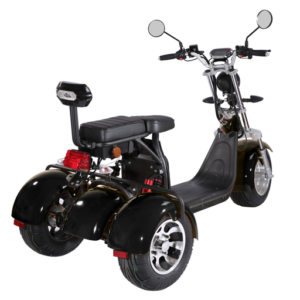
Micromobility is a revolutionary concept that holds the key to transforming urban commuting and making it more sustainable. In essence, micromobility refers to a range of small, electric-powered vehicles designed for short-distance travel within urban environments. These vehicles include e-bikes, electric scooters, Segways, and similar devices, collectively known as personal mobility devices (PMDs) in road rules.
The Surging Popularity of Electric Bikes as a Green Alternative to Cars
Electric bikes, also known as e-bikes, have witnessed an unprecedented surge in popularity as an eco-friendly alternative to cars. The COVID-19 pandemic played a pivotal role in accelerating their adoption as people sought safe and independent transportation options. Countries like the Netherlands have witnessed e-bikes outselling traditional bicycles, signifying a growing preference for electrically assisted mobility. In fact, some predictions suggest that e-bikes may even outsell motor cars in Europe within the decade, signaling a significant shift towards greener commuting solutions.
The Legal Status and Adoption of Electric Scooters and Other PMDs in Different Regions
The legal status and use of electric scooters and other Personal Mobility Devices (PMDs) vary across different states in the USA. As electric scooters become a popular method of travel in cities across the country, each state has established its own set of regulations and laws governing their usage. These laws encompass various aspects, such as who can ride electric scooters, where they can be ridden, speed limits, helmets, and minimum age requirements.
Bugatti Electric Scooter Draw Here:
Ebikes Worth Mentioning Click Here
This site sponsors affiliate links which receive a commission on sales from our websites.
How Micromobility Addresses the Challenges of Urbanization and Limited Parking Spaces
Urbanization has led to a surge in population density within cities, leading to increased challenges related to traffic congestion and limited parking spaces. Traditional commuting methods exacerbate these issues, leading to longer commute times and higher energy consumption. Micromobility presents a viable solution to address these challenges by offering compact, agile, and energy-efficient vehicles suitable for navigating congested urban environments. Electric scooters, e-bikes, and other PMDs take up significantly less space than cars and are easily maneuverable, making them ideal for last-mile connectivity and short-distance trips.
Micromobility and Its Role in Sustainable Transportation
Micromobility is a revolutionary concept that holds the key to transforming urban commuting and making it more sustainable. In essence, micromobility refers to a range of small, electric-powered vehicles designed for short-distance travel within urban environments. These vehicles include e-bikes, electric scooters, Segways, and similar devices, collectively known as personal mobility devices (PMDs) in road rules.
The Surging Popularity of Electric Bikes as a Green Alternative to Cars
Electric bikes, also known as e-bikes, have witnessed an unprecedented surge in popularity as an eco-friendly alternative to cars. The COVID-19 pandemic played a pivotal role in accelerating their adoption as people sought safe and independent transportation options. Countries like the Netherlands have witnessed e-bikes outselling traditional bicycles, signifying a growing preference for electrically assisted mobility. In fact, some predictions suggest that e-bikes may even outsell motor cars in Europe within the decade, signaling a significant shift towards greener commuting solutions.
The Legal Status and Adoption of Electric Scooters and Other PMDs in Different Regions
Electric scooters and other Personal Mobility Devices (PMDs) have varying legal status and use across different states in the USA. Similar to Australia, where e-bikes are generally legal with certain limitations, the situation for electric scooters differs between states in the USA. For example, while electric scooters are allowed in some states like California and New York, they may be restricted or banned in others like Beverly Hills and West Hollywood.
The regulations for electric scooters in the USA are not always as straightforward and clear as they should be due to the relatively new technology and their increasing popularity. Each state has its own set of laws for micromobility vehicles, leading to confusion among riders regarding what rules to follow.
To provide some clarity, under the H.R. 727 amendment of the Consumer Product Safety Act, “low-speed bicycles” with certain specifications are considered legal. While no equivalent law exists specifically for electric scooters, they are generally accepted to fall under this category. As a result, electric scooters are allowed on roads with or without bicycle lanes, as long as they are running under 25 mph.
It’s important to be aware that each state enforces its own set of rules regarding electric scooter usage on public roads. For example, the greater Los Angeles area largely follows California’s motorized scooter law, which includes speed limits, helmet requirements, and restrictions on riding on sidewalks. On the other hand, New York City has recently legalized individual-owned electric scooters with certain speed and age restrictions, but shared electric scooters are still prohibited.
Major cities in the USA, such as Los Angeles, San Francisco, and Tampa, have well-established scooter-sharing services offered by companies like Lime, Bird, Uber Jump, and Lyft. These companies provide short-term rentals for their dockless scooters, allowing users to rent them for short durations and pay per minute of usage.
However, it’s essential for users to familiarize themselves with the specific laws and operating hours of electric scooters in the city they are in, as regulations and availability may vary from one location to another.
Overall, as electric scooters gain popularity and more individuals turn to these eco-friendly modes of transport, it becomes crucial for both riders and policymakers to work together to establish clear and consistent laws across different states, ensuring safer and smoother integration of electric scooters into daily transportation.
How Micromobility Addresses the Challenges of Urbanization and Limited Parking Spaces
Urbanization has led to a surge in population density within cities, leading to increased challenges related to traffic congestion and limited parking spaces. Traditional commuting methods exacerbate these issues, leading to longer commute times and higher energy consumption. Micromobility presents a viable solution to address these challenges by offering compact, agile, and energy-efficient vehicles suitable for navigating congested urban environments. Electric scooters, e-bikes, and other PMDs take up significantly less space than cars and are easily maneuverable, making them ideal for last-mile connectivity and short-distance trips.
The Electric Revolution: Advantages of Electric Scooters
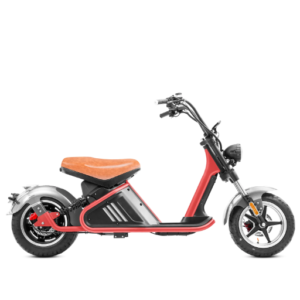
Zero Emissions: Understanding the Environmental Benefits of Electric Scooters
Electric scooters stand out as a remarkable solution to combat the environmental impact of traditional transportation methods. One of the key advantages of electric scooters lies in their zero-emission nature, which significantly reduces greenhouse gas emissions and air pollution. Unlike combustion engine vehicles that emit harmful pollutants into the atmosphere, electric scooters are equipped with electric motors that are over three times more efficient. The energy required to propel an e-scooter is just a fraction of what a car or SUV demands, making them more than 1,000% more efficient per mile compared to average combustion vehicles. Even when powered by a grid reliant on fossil fuels, the emissions per mile from electricity generation remain negligible. By adopting electric scooters as a greener mode of transportation, urban cities can take a significant step towards mitigating the adverse environmental impacts of traditional commuting methods.
Bugatti Electric Scooter Draw Here:
Ebikes Worth Mentioning Click Here
This site sponsors affiliate links which receive a commission on sales from our websites.
Urban Mobility: How Electric Scooters Offer Convenient Transportation Solutions
Electric scooters present a revolutionary approach to urban mobility, offering a convenient and efficient transportation solution for short-distance trips within cities. These small-wheeled electric vehicles provide a more enjoyable and time-saving option for making short journeys. With the ease of renting and unlocking e-scooters using smartphone apps, riders can access them on-demand and cover the last-mile of their commutes seamlessly. Electric scooters also play a crucial role in reclaiming public space for bikes and increasing the usage of public transit. By integrating electric scooters into the existing mobility ecosystem, cities can enhance overall accessibility, reduce congestion, and promote a more interconnected transportation network.
Cost-Effectiveness and Reduced Congestion: The Economic Advantages of Electric Scooters
In addition to their environmental benefits, electric scooters offer compelling economic advantages. Compared to traditional cars, the cost of owning, maintaining, and operating electric scooters is significantly lower. The cost per mile for e-scooters is considerably reduced due to their energy-efficient electric motors. Furthermore, electric scooters play a pivotal role in reducing traffic congestion, especially in urban areas. With their nimble design and ability to navigate through traffic more easily, electric scooters alleviate the burden of congestion on roadways, leading to smoother traffic flow and faster commute times. Moreover, as more people opt for e-scooters for their daily commuting needs, the overall demand for limited parking spaces in crowded urban settings is alleviated.
Promoting Eco-Conscious Commuting: How Electric Scooters Fit into a Greener Lifestyle
Embracing electric scooters as a mode of urban commuting aligns with the principles of eco-conscious living. By choosing zero-emission transportation options like e-scooters, individuals actively contribute to reducing their carbon footprint and mitigating climate change. Electric scooters promote a greener lifestyle, fostering awareness of sustainable transportation choices. As riders experience the convenience and efficiency of electric scooters, they are encouraged to adopt environmentally friendly practices in other aspects of their lives. Additionally, the proliferation of electric scooters encourages cities to prioritize sustainable urban planning, leading to the development of greener infrastructure and policies.
Technological Advancements: Improving Battery Efficiency and Energy Density
Advancements in battery technology play a crucial role in the continuous improvement of electric scooters. Lithium-ion batteries, the preferred power source for electric scooters, have seen a remarkable reduction in cost and improvement in energy density over the years. The drop in battery prices and improvements in energy density allows for longer battery life and increased range for e-scooters, making them more viable for daily commuting needs. Technological innovations such as swappable batteries and improved battery management systems further enhance the efficiency and convenience of using electric scooters. As battery technology continues to evolve, electric scooters are poised to become even more efficient and accessible, further accelerating the electric revolution in urban commuting.
Micromobility emerges as a promising solution to revolutionize urban commuting and combat the environmental impact of traditional transportation methods. The growing popularity of electric bikes and other PMDs signifies a shift towards more sustainable and eco-friendly transportation choices. As governments and urban planners recognize the benefits of micromobility in reducing greenhouse gas emissions, tackling congestion, and enhancing urban mobility, we can expect to see further advancements and adoption of these green transportation options. By embracing micromobility, urban cities can pave the way for a greener and more sustainable future of urban commuting.
FAQs: The Future of Micromobility and Urban Transportation

- How do electric scooters contribute to reducing greenhouse gas emissions?Electric scooters are over three times more energy-efficient than traditional combustion engine vehicles, making them a cleaner and greener mode of transportation. They produce zero tailpipe emissions, thereby reducing the carbon footprint and helping combat climate change.
- Are electric scooters legal in all regions?The legal status of electric scooters varies across different regions and countries. While some areas have embraced electric scooters and integrated them into their transportation systems, others may have specific regulations or restrictions in place. It’s essential to check local laws and regulations before using electric scooters.
- How does micromobility address the challenges of urbanization and limited parking spaces?Micromobility, including electric scooters and e-bikes, provides a solution to the challenges posed by urbanization and limited parking spaces. With their compact size and efficient energy use, electric scooters offer a convenient and flexible alternative for short-distance commutes, reducing the need for larger vehicles and parking spaces.
- What role do regulatory bodies play in shaping the micromobility landscape?Regulatory bodies play a crucial role in establishing guidelines and standards for the safe integration of electric scooters and other PMDs into urban transportation. They work in collaboration with city officials and micromobility providers to ensure safety, efficiency, and compliance with local laws.
- How can electric scooters help reduce traffic congestion in cities?Electric scooters can help reduce traffic congestion by offering a viable alternative to private car usage for short-distance trips. With more people opting for electric scooters, the overall volume of cars on the roads decreases, leading to smoother traffic flow and less congestion.
- What are some technological advancements driving the future of micromobility?Technological innovations in the micromobility sector include the development of electric scooters with longer battery life, swappable batteries, improved energy density, and innovative designs like Walkcars and electric unicycles. These advancements contribute to enhanced efficiency and accessibility of micromobility solutions.
- How can micromobility contribute to promoting sustainable urban living?Micromobility supports sustainable urban living by reducing greenhouse gas emissions, air pollution, and noise levels. By providing eco-friendly transportation options, micromobility encourages a shift towards greener lifestyles, promoting environmental consciousness and sustainable city living.
- Will electric scooters replace other modes of transportation entirely?While electric scooters have gained popularity as a convenient urban transportation option, they are not likely to replace other modes of transportation entirely. Instead, they complement existing transportation systems, filling the gap for short-distance commutes and providing an eco-friendly alternative to cars.
- How do shared scooter trials contribute to the future of micromobility?Shared scooter trials serve as valuable testing grounds to assess the feasibility and impact of electric scooters on urban transportation. The data and feedback collected from these trials help inform future policies and decisions regarding the integration of electric scooters into cities.
- Can micromobility revolutionize the way we view public space allocation?Yes, micromobility can revolutionize public space allocation by advocating for a reallocation of space towards protected bike and scooter lanes, wider sidewalks, and improved public transit infrastructure. By promoting a more efficient use of public space, micromobility contributes to enhanced livability and congestion reduction in urban areas.
WARNING:

Before you go Enter the Draw for the Bugatti Electric Scooter Draw Here:
Ebikes Worth Mentioning Click Here
Back to Top
To use our purchasing process you must be 18 years of age or older to purchase any product on our website and not represent or purchase on behalf of anyone under this age as set at the point of purchase. The scooter will be registered on our database to the Name and Address etc of the purchaser.
This post or page may contain affiliate links that may earn a small commission at no additional cost to you. I use affiliate links because they allow me to share useful products and services with you that are related to the topic of my website. Affiliate links also help me earn some income from my website, which enables me to keep creating high-quality content for you. I appreciate your support and trust!
Exploring the Benefits and Versatility of Electric Big Wheel Scooters:

Big Wheel Scooters
In recent years, big wheel scooters have gained popularity as a versatile and practical mode of transportation. Technological advancements have led to the development of electric and gas-powered versions of these scooters.
Electric-powered big wheel scooters utilize an electric motor to provide propulsion instead of relying on human power. They typically feature a rechargeable battery pack, an electric motor, and a controller for regulating speed and power delivery. The design and overall structure of electric big wheel scooters are similar to their traditional counterparts.
Scooters with big wheels, also known as “big wheel scooters,” they are characterized by larger diameter wheels compared to standard scooters.
Electric-Powered Big Wheel Scooters
The electric motor is what provides the power for the scooter. It is typically located in the rear wheel hub or the deck of the scooter. Some models store the battery in the deck of the scooter but this limits precious deck storage.
Features of Electric-Powered Big Wheel Scooters
Electric battery packs for scooters typically consist of a series of lithium-ion cells that are connected together in a pack. The battery pack is then enclosed in a protective case that is designed to protect the cells from damage. The battery pack is typically located under the deck of the scooter, where it is secured in place.
The size and weight of the battery pack will vary depending on the power output of the scooter. Scooters with higher power outputs will require larger and heavier battery packs. The battery pack will also affect the range of the scooter. Scooters with larger battery packs will have a longer range.
The battery pack will need to be charged regularly. The charging time will vary depending on the size of the battery pack. Smaller battery packs will typically take less time to charge than larger battery packs.
It is important to properly maintain the battery pack to ensure that it lasts for a long time. This includes keeping the battery pack clean and dry and avoiding charging it in extreme temperatures.
The battery pack stores the power for the electric motor. It is typically located under the deck of the scooter.
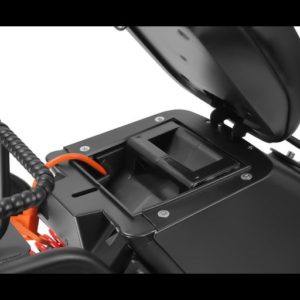
Bugatti Electric Scooter Draw Here:
Ebikes Worth Mentioning Click Here
Electric Battery Pack For Scooters
Electric battery packs for scooters typically consist of a series of lithium-ion cells that are connected together in a pack. The battery pack is then enclosed in a protective case that is designed to protect the cells from damage. The battery pack is typically located under the deck of the scooter, where it is secured in place.
The size and weight of the battery pack will vary depending on the power output of the scooter. Scooters with higher power outputs will require larger and heavier battery packs. The battery pack will also affect the range of the scooter. Scooters with larger battery packs will have a longer range.
The battery pack will need to be charged regularly. The charging time will vary depending on the size of the battery pack. Smaller battery packs will typically take less time to charge than larger battery packs.
It is important to properly maintain the battery pack to ensure that it lasts for a long time. This includes keeping the battery pack clean and dry and avoiding charging it in extreme temperatures.
The battery pack stores the power for the electric motor. It is typically located under the deck of the scooter.
Electronic Speed Controller (ESC) of an Electric Scooter
The controller is a small electronic device that is typically located on the handlebar of the scooter. It is responsible for regulating the speed and power delivery of the electric motor. The controller receives input from the throttle, which is a lever that the rider uses to control the speed of the scooter. The controller then uses this input to control the amount of power that is sent to the motor.
The controller also has a number of other features, such as a brake cutoff, which cuts off power to the motor when the brake is applied. The controller also has a number of safety features, such as over-current protection, which prevents the motor from drawing too much power.
The controller is an important part of the electric scooter and it is essential for safe and reliable operation. If the controller fails, the scooter will not be able to move. It is important to regularly inspect the controller for signs of damage or wear and tear. If the controller is damaged, it should be replaced immediately.
The controller regulates the speed and power delivery of the electric motor. It is typically located on the handlebar of the scooter.
Regenerative Braking Systems
Regenerative braking is a process that converts the kinetic energy of a moving vehicle into electrical energy that can be stored in a battery or used to power other electrical devices. In an electric scooter, regenerative braking works by using the electric motor as a generator. When the rider applies the brakes, the motor spins in the opposite direction, generating electricity. This electricity is then stored in the battery, which can then be used to power the scooter’s motor.
Regenerative braking can help to extend the range of an electric scooter by up to 20%. It can also help to reduce wear and tear on the scooter’s brake pads.
Regenerative braking is not a new technology. It has been used in hybrid and electric cars for many years. However, it is becoming more common in electric scooters as the technology improves and the cost of batteries decreases.
Some electric-powered big wheel scooters feature regenerative braking. This means that the scooter’s electric motor can generate electricity when it brakes. This electricity can then be stored in the battery pack, which can extend the range of the scooter.
Advantages Of Traditional Scooters
Increased speed: Electric-powered big wheel scooters can typically reach speeds of up to 20 mph or more. This makes them a faster option for commuting or getting around town.
Increased range: Electric-powered big wheel scooters typically have a range of 10-20 miles on a single charge. This means that you can travel further without having to worry about running out of power.
The speed of an electric scooter will depend on a number of factors, including the power of the motor, the size of the battery, and the weight of the rider. Scooters with more powerful motors and larger batteries will typically be able to reach higher speeds. Riders who are heavier will also need a more powerful motor to reach the same speeds as lighter riders.
It is important to note that the speed of an electric scooter is also limited by the law. In most areas, electric scooters are limited to speeds of 15 mph or less. If you are caught riding an electric scooter that is exceeding the speed limit, you could be ticketed or even arrested.
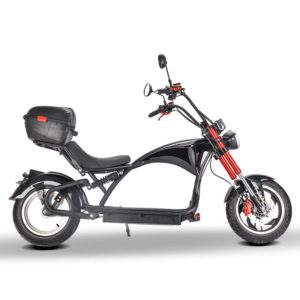
Suitable Riding Environments
Big wheel scooters are suitable for various environments, including urban streets, parks, and even light off-road conditions.
They can handle different surfaces like pavement, gravel, and grass with greater ease, expanding their utility. Their stability and ability to handle various terrains make them ideal for navigating city streets and bike lanes.
Big wheel scooters are typically larger and heavier than standard scooters. This is due to the larger wheels and sturdier frame, which are necessary to accommodate the larger wheels. The increased size and weight can make big wheel scooters less portable and challenging to carry or store.
Big wheel scooters are typically more expensive than standard scooters. This is due to the cost of the larger wheels and frame. Big-wheeled scooters may not be as fast or agile as standard scooters. This is because the larger wheels and frame create more drag and inertia.
Simple controls: Electric-powered big wheel scooters typically have simple controls, making them easy to learn how to use. The main controls are the throttle, which controls the speed of the scooter, and the brake, which slows down or stops the scooter.
Stability: Electric-powered big wheel scooters are typically very stable, making them easy to ride even for beginners. The large wheels and wide deck provide a stable platform for the rider, and the scooter’s weight distribution helps to keep it balanced.
Environmentally friendly: Electric-powered big wheel scooters are a more environmentally friendly option than traditional scooters. They do not produce emissions, which can help to improve air quality.
Ease of Use
Electric-powered big wheel scooters are typically very easy to use. Simply turn on the scooter and press the throttle to start riding. expand on easy to ride. The large wheels and wide deck of electric-powered big wheel scooters provide a comfortable ride, even on uneven terrain. This makes them a good option for riders of all sizes and skill levels.
Bugatti Electric Scooter Draw Here:
Ebikes Worth Mentioning Click Here
Commuting
The wheels on these scooters typically range from 8 to 12 inches in diameter, offering increased stability making big wheel scooters suitable for riders of all skill levels and improved ride quality. The design often includes a wider deck, taller handlebars, and a sturdier frame to accommodate the larger wheels. They can handle rough terrain more effectively, absorbing bumps and vibrations for a smoother ride.
The wider deck offers more foot space, allowing riders to adopt a comfortable stance. As a result, big wheel scooters can often last longer than smaller scooters.
Big wheel scooters are well-suited for commuting due to their features, including:
- Wheels ranging from 8 to 12 inches in diameter, offering increased stability
- Wider deck, taller handlebars, and sturdier frame to accommodate the larger wheels
- Effective handling of rough terrain, absorbing bumps and vibrations
- More foot space on the wider deck, allowing for a comfortable stance
- Longer lifespan compared to smaller scooters
Recreation and Sport
Big wheel scooters can be used for recreational purposes, such as riding around the park or neighborhood. They are also suitable for scooter freestyle, which involves performing tricks and stunts. The larger wheels provide more stability and control, making them ideal for these activities. Additionally, electric-powered big wheel scooters operate quietly, minimizing noise pollution and offering a more pleasant riding experience.
Extending the Range of Your Electric Scooter
Ride at a slower speed: The faster you ride, the more power your scooter will use. Riding at a slower speed will help to extend the battery life of your electric scooter, especially if it has big wheels. This is because big wheels require more power to get up to speed, so running them at a slower speed will help to conserve battery power.
Use eco mode: Most electric scooters have an eco mode that limits the top speed and power output, which can help to extend battery life.
Avoid sudden acceleration and braking: Sudden acceleration and braking can put a strain on the battery and shorten its lifespan.
Keep the battery charged: When you’re not using your scooter, it’s a good idea to keep the battery charged to at least 50%. This will help to prevent the battery from deep discharging, which can damage it.
Store the battery in a cool, dry place: Extreme temperatures can shorten the lifespan of a battery. If you’re not using your scooter for an extended period of time, store the battery in a cool, dry place.
Disadvantages
Of course, there are also some disadvantages to big wheel scooters. One of the biggest disadvantages is that they are more difficult to carry and store than scooters with smaller wheels. This is because the larger wheels and frame take up more space. This makes it impossible to fold them and place them in a trunk or cat boot for transport to locations.
Electric scooters have a finite range determined by the battery capacity, which may restrict longer trips without access to charging stations.
The range of an electric scooter will vary depending on a number of factors, including the size and type of battery, the weight of the rider, and the terrain being ridden on. In general, electric scooters can travel between 10 and 20 miles on a single charge. However, there are some models that can travel up to 30 or even 40 miles on a single charge.
If you are planning on taking long trips on your electric scooter, it is important to make sure that you have access to charging stations along the way. You can also consider purchasing additional batteries or a scooter with a larger battery capacity.
The availability and accessibility of charging infrastructure can vary depending on the location. In some areas, there may be a lot of charging stations available, while in other areas, there may be very few or none at all. This can make it necessary to plan your routes accordingly if you are using an electric scooter.
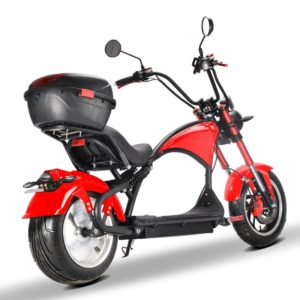
Riding On Uneven Terrain
Riding on uneven terrain can put more strain on your scooter’s motor and battery, which can reduce range. This is because the motor has to work harder to maintain speed and momentum on uneven surfaces, and the battery has to provide more power to the motor.
If you do need to ride on uneven terrain, there are a few things you can do to help reduce the impact on your scooter’s range:
Slow down: Riding at a slower speed will put less strain on your scooter’s motor and battery.
Choose a smoother path: If possible, try to avoid riding on rough or rocky terrain. If you must ride on uneven terrain, try to find a path that is as smooth as possible.
Be aware of your surroundings: When riding on uneven terrain, it is important to be aware of your surroundings and avoid obstacles. This will help you to avoid sudden stops or turns, which can put a strain on your scooter’s motor and battery.
Higher Upfront Cost
Despite the higher upfront cost, electric big wheel scooters can offer a number of advantages over gas-powered scooters, such as:
Lower operating costs: Electric scooters do not require gasoline, so they have lower operating costs. This can save you money in the long run, especially if you use your scooter frequently.
Environmentally friendly: Electric scooters produce zero emissions, so they are better for the environment than gas-powered scooters.
Quieter operation: Electric scooters are much quieter than gas-powered scooters, which can make them a better option for use in urban areas.
Smoother ride: The larger wheels on electric big wheel scooters can provide a smoother ride over rough terrain.
If you are considering buying an electric scooter, you should factor in the higher upfront cost, but you should also consider the long-term savings and environmental benefits.
Future Trends of Electric Big Wheel Scooters

Urban Mobility: Electric big wheel scooters are well-suited for short to medium-range commuting within urban areas due to their efficiency, quiet operation, and lower environmental impact. They are a great option for getting around town without having to worry about traffic or parking. They are also relatively affordable, making them a more accessible option for people of all income levels.
Recreation and Sport: Both electric and gas-powered big wheel scooters can be used for recreational purposes, providing an exhilarating riding experience and engaging in scooter-based activities. They can be used for racing, touring, or simply for enjoying a leisurely ride around town.
Technological Advancements: With ongoing developments in battery technology and the growth of electric vehicle infrastructure, electric big wheel scooters are likely to become even more viable and popular in the future. As batteries become more powerful and longer-lasting, electric scooters will be able to travel longer distances on a single charge. As more charging stations are installed, it will be easier to find a place to charge your scooter when you need to.
Finally, electric big wheel scooters are a versatile and convenient transportation option that is well-suited for a variety of uses. As technology continues to improve, they are likely to become even more popular in the years to come.
WARNING:

Before you go Enter the Draw for the Bugatti Electric Scooter Draw Here:
Ebikes Worth Mentioning Click Here
Back to Top
To use our purchasing process you must be 18 years of age or older to purchase any product on our website and not represent or purchase on behalf of anyone under this age as set at the point of purchase. The scooter will be registered on our database to the Name and Address etc of the purchaser.
This post or page may contain affiliate links that may earn a small commission at no additional cost to you. I use affiliate links because they allow me to share useful products and services with you that are related to the topic of my website. Affiliate links also help me earn some income from my website, which enables me to keep creating high-quality content for you. I appreciate your support and trust!
Exploring the 49cc Gas Scooter: Review
Exploring the 49cc Gas Scooter: Features and Upgrades
When it comes to exhilarating rides, a 49cc Gas Scooter is an excellent choice for those seeking power and performance. These two-stroke motorbikes possess distinct characteristics that set them apart from other models. In this blog post, we will delve into the intricacies of these scooters, exploring key aspects such as rear suspension upgrades, muffler options, seat removal processes, fuel efficiency and range. We’ll also discuss convenient valve extenders for tire maintenance and the proper starting procedure involving choke usage. By understanding these elements of your 2-Stroke Scooter better, you can ensure optimal performance during every ride while keeping your scooter in top-notch condition.
The 49cc Gas Scooter
Discover the benefits of owning a fast and efficient 49cc 2-stroke gas scooter, perfect for both on-road and off-road use. This powerful scooter can reach speeds of up to 35mph while maintaining excellent fuel efficiency with its one-liter tank.
Key Features That Make This Scooter Stand Out From Competitors
- Powerful engine: The 49cc two-stroke engine provides enough power to easily navigate city streets or tackle off-road trails, making it versatile for various riding conditions.
- Fuel efficiency: With a one-liter gas tank, you can travel approximately twenty miles before needing to refuel. This makes it an economical choice for daily commutes or weekend adventures.
- Rear suspension system: A high-quality rear suspension ensures a smooth ride by absorbing bumps and vibrations on uneven surfaces, improving overall comfort during your journey.
- User-friendly design: Easy seat removal process allows quick access when performing maintenance tasks such as adjusting or replacing parts related directly back into areas where these types may benefit from using those services themselves.
How the Rear Suspension Improves Ride Comfort
A good rear suspension system is essential in providing a comfortable riding experience. It works by absorbing shocks caused by bumps and uneven terrain, ensuring that you have better control over your scooter even at high speeds. In addition, it reduces vibration felt through the handlebars and seat post which helps protect vital components like the engine from damage due to excessive shaking. Upgrading your stock rear suspension to a more advanced system can further enhance your scooter’s performance and comfort. Some choices include adjustable shocks for customizing stiffness based on your riding style, or even air suspension systems to provide an ultra-smooth ride. For those seeking a combination of speed, fuel efficiency, and versatility, investing in a 49cc 2-stroke gas scooter is an ideal choice; with the right rear suspension system upgrade, it can be even more enjoyable. With its powerful engine and top-notch rear suspension system, this scooter will make every ride enjoyable while saving you money on gas expenses. Don’t forget to consider upgrading your rear suspension for even better performance.
Bugatti Electric Scooter Draw Here:
Ebikes Worth Mentioning Click Here
Key Takeaway: When choosing a muffler for your 49cc Gas Scooter, you have two options: the stock muffler or an aftermarket street muffler. The stock option prioritizes function over form and is designed to handle different terrains effectively, while the street option offers improved aesthetics and sound but may not significantly enhance overall performance. Your choice should depend on where you plan to ride your scooter most frequently – smooth roads with minimal bumps or rough terrain.
Rear Suspension Upgrade
One of the most significant improvements you can make to your 49cc Gas Scooter is installing a rear suspension upgrade. This essential addition, located right underneath your seat, drastically enhances ride comfort and protects vital components like the engine from excessive vibrations. In this section, we’ll discuss the benefits of having a rear suspension system on your scooter and how it helps protect crucial parts.
Benefits of Installing a Rear Suspension System on Your Scooter
A well-designed rear suspension system offers numerous advantages for riders seeking optimal performance and comfort. First and foremost, it significantly reduces vibration by around 80%, ensuring a smoother ride even when traversing rough terrain or uneven surfaces. Additionally, an upgraded rear suspension provides better handling capabilities as it allows for improved weight distribution across the scooter’s frame.
- Smoother Ride: By absorbing shocks from bumps and uneven road surfaces more effectively than stock suspensions, an upgraded system ensures you enjoy comfortable rides every time.
- Better Handling: Improved weight distribution translates into enhanced control over turns and overall stability while riding at high speeds or navigating tricky terrains.
- Durability: Upgraded suspensions are typically built with higher-quality materials that withstand wear-and-tear better than their stock counterparts – meaning they last longer without needing frequent replacements or repairs.
Protecting Vital Components Like The Engine
An often-overlooked benefit of upgrading your scooter’s rear suspension is its role in safeguarding critical components such as the engine against damage caused by excessive shaking during rides. Vibrations can cause bolts to come loose, potentially leading to engine failure or other serious issues that may require costly repairs. By reducing vibrations significantly, a rear suspension upgrade not only ensures better ride comfort but also helps maintain the integrity of your scooter’s vital parts. In turn, this translates into an extended lifespan and reduced maintenance costs for your trusty 2-stroke gas scooter. In summary, investing in a rear suspension upgrade is an excellent decision for any 49cc 2-stroke gas scooter owner looking to enhance their riding experience while protecting essential components from potential damage caused by excessive vibrations. So go ahead and give your beloved scooter the upgrade it deserves, and enjoy smoother rides with peace of mind.
Muffler Options
When selecting a muffler for your 49cc Gas Scooter, you can either keep the stock one or upgrade to an aesthetically pleasing street version. It’s essential to understand how each type performs and when you should opt for one over the other based on riding conditions.
Comparing Performance Between Stock and Street Mufflers
The stock muffler is designed specifically for your scooter, ensuring optimal performance in various road conditions. While it may not be as visually appealing as an aftermarket option, its primary purpose is functionality. On the other hand, street mufflers are often chosen for their sleek design and enhanced sound output. Nevertheless, these aftermarket options may not necessarily provide a substantial boost in terms of their effectiveness when compared to standard versions.
- Stock Mufflers: Designed for optimal performance across different terrains; prioritizes function over form.
- Street Mufflers: Offers improved aesthetics and sound but may not significantly enhance overall performance.
When To Opt For Each Type Depending On Road Surfaces
Your choice between a stock or street muffler should largely depend on where you plan to ride your scooter most frequently. If you primarily use your scooter on smooth roads with minimal bumps or rough terrain, then upgrading to a stylish street muffler could be worthwhile – especially if appearance matters greatly to you. In contrast, if off-road adventures or frequent encounters with uneven surfaces are part of your regular rides, sticking with the reliable stock option would likely serve you better. The stock muffler is designed to handle these conditions more effectively, ensuring a smoother and safer ride. Weighing up the advantages and disadvantages for your individual needs and desires is essential. While both types can work well for different riders, understanding their performance capabilities in various road conditions will help you make an informed decision that best suits your scooter lifestyle.
Easy Seat Removal Process
Scooter owners understand that keeping their vehicle in prime condition necessitates regular maintenance. One of the essential aspects of maintaining your 49cc 2-stroke gas scooter is having easy access to its components. In this section, we’ll explore how simple it is to remove your seat post without any hassle or complicated tools required.
Step-by-step guide for removing seats efficiently
- Locate the seat latch: Begin by finding the latch underneath the rear part of your seat. This latch holds the seat securely in place while riding and allows for quick removal when needed.
- Lift and pull: Gently lift up on the back portion of your seat while pulling towards yourself. The latch should release, allowing you to slide out from under it easily.
- Carefully remove: With one hand holding onto both sides near where they connect with their hinges, carefully lift upwards until completely free. Be mindful not to damage any surrounding parts during the process.
This straightforward procedure ensures that you can quickly access areas requiring maintenance or adjustments without wasting time fumbling around with complex mechanisms or tools.
Why quick access matters during routine maintenance
Maintaining a well-functioning scooter requires regular check-ups and occasional repairs – especially if used frequently off-road. Having easy-to-remove seats makes these tasks much more manageable by providing direct entry points into vital sections such as the engine compartment, fuel tank area, and exhaust system connections among others. Not only does this save valuable minutes spent struggling through cumbersome disassembly processes but also reduces the risk of damaging delicate components along the way. In addition, performing periodic inspections becomes significantly easier when there’s no need to remove multiple parts or use specialized tools just to access the area you need. This convenience ultimately leads to a more enjoyable and hassle-free riding experience, as well as prolonging the lifespan of your scooter. For more tips on maintaining your 49cc 2-stroke gas scooter, check out our comprehensive scooter maintenance guide. With the right maintenance, you can keep your scooter running optimally for an extended period.
Bugatti Electric Scooter Draw Here:
Ebikes Worth Mentioning Click Here
Fuel Efficiency and Range
When it comes to gas scooters, fuel efficiency and range are crucial factors for riders who want to enjoy extended rides without constantly worrying about refueling. In this section, we’ll delve into the details regarding fuel consumption rates of 49cc 2-stroke gas scooters and how you can maximize their efficiency.
Understanding Two-Cycle Oil Requirements
To ensure optimal performance and longevity of your scooter’s engine, it is essential to use two-cycle oil, which must be mixed with gasoline at a ratio of four ounces per gallon. This specific type of oil provides necessary lubrication for internal components while also helping reduce emissions. Always refer to your scooter’s manual for proper mixing instructions and never skip on using high-quality two-cycle oil as doing so may lead to engine damage or reduced performance.
Maximizing Fuel Efficiency for Extended Rides
- Maintain Proper Tire Pressure: Underinflated tires increase rolling resistance, leading to higher fuel consumption. Ensure that your tires are inflated according to the manufacturer’s recommendations found in the owner’s manual.
- Avoid Unnecessary Weight: Carrying extra weight puts more strain on the engine, resulting in increased fuel usage. Remove any unnecessary items from your scooter before heading out on a ride.
- Ride Smoothly: Accelerating quickly or braking hard consumes more fuel than riding smoothly at consistent speeds. Practice good throttle control by gradually increasing speed when starting off and avoiding sudden stops whenever possible.
- Maintain Your Scooter Regularly: A well-maintained scooter runs more efficiently, resulting in better fuel economy. Perform routine maintenance tasks such as cleaning the air filter, changing spark plugs, and checking for any leaks or loose bolts.
With a one-liter capacity tank on your 49cc 2-stroke gas scooter, you can expect to cover approximately twenty miles before needing to refuel. By following these tips and understanding the importance of using two-cycle oil mixed at four ounces per gallon, you’ll be able to enjoy extended rides while maximizing your scooter’s fuel efficiency.
Convenient Valve Extender and Tire Maintenance
To ensure a comfortable and safe ride, proper tire maintenance is an essential part of keeping your 2-stroke scooter in optimal condition. Regular tire upkeep not only guarantees a pleasant and effortless journey but also assists in prolonging the lifespan of your scooter’s motor and other essential parts. In this section, we will discuss how using a valve extender can make tire maintenance much more convenient for you
How Valve Extenders Simplify Tire Maintenance
A valve extender is an essential accessory that makes it easier to inflate or deflate your scooter’s tires without having to remove them from the wheel. This handy tool connects directly to the existing valve stem on your tire, allowing you to access it easily with a standard air pump or pressure gauge. By eliminating the need for removing tires during routine maintenance tasks such as checking air pressure or inflating them, valve extenders save time and effort while ensuring proper care for your 2-stroke scooter.
Proper Installation and Use of This Essential Tool
To install a valve extender on your scooter’s tire, follow these simple steps:
- Clean any dirt or debris around the original valve stem before attaching the extender.
- Screw one end of the valve extender onto your existing tire valve stem by turning it clockwise until tight (about 20 turns).
- The other end should now be accessible outside of any obstructions like spokes or brake discs – connect this part with an air pump nozzle when needed.
- To check if everything works correctly after installation, try inflating/deflating through new extended valves using a standard pump or pressure gauge.
Once the valve extender is installed, you can easily maintain your scooter’s tires by following these tips:
- Check tire pressure regularly – at least once a month or before long rides. Use a reliable tire pressure gauge to ensure accurate readings.
- Ensure your tires are filled to the manufacturer’s recommended PSI for optimal operation and safety.
- Inspect your tires for any signs of damage, such as cuts, punctures, or excessive wear. Replace them if necessary to avoid potential accidents and costly repairs down the road.
Maintaining proper tire care with the help of convenient accessories like valve extenders not only enhances your riding experience but also contributes significantly towards ensuring longevity and reliability in your 2-stroke scooter.
Starting Procedure and Choke Usage
Familiarizing yourself with the proper starting procedures for your 49cc 2-stroke gas scooter is essential to ensure smooth operation every time you ride. This includes priming the engine, setting the choke position when cold, and shutting off the scooter with just one button. In this section, we’ll discuss these steps in detail along with their importance.
Importance of Correct Choke Usage During Startup
The choke plays a crucial role in starting your scooter’s engine, especially when it’s cold. By restricting airflow into the carburetor, it enriches the fuel mixture and makes it easier for combustion to occur. When starting your gas scooter, follow these simple steps:
- Locate the choke lever on your scooter (usually near or on top of the carburetor).
- If you’re starting a cold engine (i.e., hasn’t been running recently), set the choke lever to its “closed” or “on” position.
- If you’re restarting a warm engine (i.e., has been running within the last few minutes), leave the choke lever in its “open” or “off” position.
Note that using an incorrect choke setting can lead to poor performance or difficulty getting started at all.
Quick Shut-off Feature for Added Safety
Your safety should always be a priority while riding any motorized vehicle – including scooters. The quick shut-off feature built into most modern scooters ensures that turning off power is as easy as pressing one button located near the handlebars. Quickly and safely stopping your scooter is a breeze with the one-button shut off feature conveniently located near the handlebars.
Starting Your Scooter: A Step-by-Step Guide
Now that we’ve covered choke usage and shut-off features, let’s go through a step-by-step guide on starting your scooter:
- Ensure the fuel valve is open (usually located under the seat).
- Prime the engine by pressing the bulb underneath until you feel resistance – this helps draw fuel into the carburetor for easier starting.
- Set the choke lever according to whether the engine is cold or warm (as discussed earlier).
- Pull the starter cord gently until you feel tension, then give it a firm pull – repeat as necessary until the engine starts running smoothly.
- If using the choke during startup, gradually return the lever back to the “open” position once the engine warms up and runs consistently without stalling.
Incorporating these best practices when starting your scooter will not only ensure smooth operation but also help prolong its lifespan. Happy riding.
Key Takeaways
Overall, the 49cc Gas Scooter is a great option for those looking for an efficient and fun mode of transportation. This scooter stands out from its competitors with features like rear suspension upgrades, muffler options, an easy seat removal process, fuel efficiency and range optimization, a convenient valve extender, and tire maintenance tools, as well as proper starting procedure and choke usage. If you need a dependable 2-Stroke Scooter for your everyday rides or weekend getaways, head over to GotScooters.com right away! We have a number of Electric Stand Up and Sit down scooters to choose from.
WARNING:

Before you go Enter the Draw for the Bugatti Electric Scooter Draw Here:
Ebikes Worth Mentioning Click Here
Back to Top
To use our purchasing process you must be 18 years of age or older to purchase any product on our website and not represent or purchase on behalf of anyone under this age as set at the point of purchase. The scooter will be registered on our database to the Name and Address etc of the purchaser.
This post or page may contain affiliate links that may earn a small commission at no additional cost to you. I use affiliate links because they allow me to share useful products and services with you that are related to the topic of my website. Affiliate links also help me earn some income from my website, which enables me to keep creating high-quality content for you. I appreciate your support and trust!
The Rise of Electric Scooters with Seats: Enhancing Mobility and Convenience
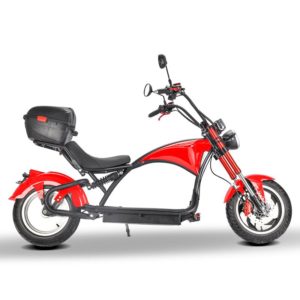
Discover the perfect balance of comfort and convenience with Electric Scooters with Seats. Enjoy a smooth ride and enhanced stability. #EcoFriendlyMobility While traditional electric scooters have gained traction, a new trend has emerged: the electric scooter with a seat. This innovation combines the agility and compactness of a scooter with the comfort and stability of a seated ride. In this article, we will explore the features, benefits, and impact of electric scooters with seats, highlighting their potential to revolutionize personal mobility.
The Rise of Electric Scooters With Seats
In recent years, there has been a surge in the popularity of electric scooters as a means of transportation, especially in urban areas. Electric scooters offer several advantages over traditional gasoline-powered scooters and cars, such as affordability, compactness, and eco-friendliness. They are powered by electric motors and rechargeable batteries, eliminating the need for fossil fuels and reducing carbon emissions.
The rise of electric scooters can be attributed to various factors. Firstly, the advancements in battery technology have led to the development of more efficient and lightweight batteries, allowing for longer riding ranges and quicker charging times. This has significantly improved the practicality and usability of electric scooters.
Secondly, the growing concern for environmental sustainability and the need for greener transportation alternatives have propelled the popularity of electric scooters. As cities strive to reduce air pollution and congestion, electric scooters have emerged as a viable solution for short-distance commuting and last-mile transportation.
Limitations of Traditional Electric Scooters
While traditional electric scooters have gained widespread acceptance, they do come with certain limitations. One of the primary limitations is the lack of seating options. Traditional electric scooters typically feature a standing platform, requiring the rider to remain in a standing position throughout the ride. This can be tiring, especially during long commutes or for individuals with mobility issues.
Additionally, the lack of seating can impact the stability and balance of the rider, especially at higher speeds or on uneven terrain. This can be a safety concern, particularly for novice riders or those who may have difficulty maintaining balance while standing
Introduction of Electric Scooters with Seats
To address the limitations of traditional electric scooters and provide a more comfortable riding experience, manufacturers have introduced electric scooters with seats. These scooters retain the compactness and agility of their standing counterparts while incorporating a seat for the rider.
Electric scooters with seats come in various designs, including a single seat, dual seats, or even a bench-style seat for multiple riders. The seats are usually padded and ergonomically designed to offer comfort and support during the ride.
The introduction of seats in electric scooters has expanded their user base by making them more accessible to a wider range of individuals. People who may have found standing for extended periods challenging, such as older adults or individuals with physical disabilities, can now enjoy the convenience and efficiency of electric scooters.
Furthermore, the addition of seats improves the stability and balance of the rider, enhancing safety during the ride. Riders can maintain better control over the scooter, especially during turns or on uneven surfaces.
Features and Components
Electric scooters with seats feature a frame design that accommodates the seating arrangement while maintaining the compactness and maneuverability of traditional electric scooters. The frames are typically constructed using lightweight materials such as aluminum or high-strength steel to ensure durability without compromising on weight.
The design of the frame focuses on stability and balance. The center of gravity is positioned low to enhance stability, and the frame is engineered to distribute the weight evenly, optimizing the scooter’s handling and performance. The frame may also incorporate suspension systems, such as front forks or rear shocks, to absorb shocks and vibrations, improving the overall comfort of the ride.
Seat Options and Adjustability
Electric scooters with seats offer various seating options to cater to different preferences and requirements. Single-seat designs are the most common, providing a comfortable and dedicated seating position for the rider. Dual-seat designs are also available, enabling two individuals to ride together.
The seats are typically padded and contoured to provide optimal comfort during the ride. Some seats may have adjustable features, allowing riders to customize the seat height and angle to suit their preferences. This adjustability ensures that riders of different heights and body types can find a comfortable riding position. Before you take a pillion passenger on your bike, make sure you know the licensing and legal requirements in your area.
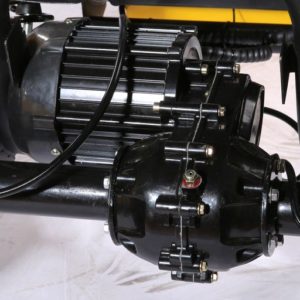
Electric Motor and Battery
Electric scooters with seats are equipped with electric motors that provide the necessary power for propulsion. The motor’s specifications may vary depending on the scooter model, but they are generally designed to offer a balance between performance and efficiency. The motors are often brushless to reduce maintenance needs and provide smoother acceleration.
The battery is a crucial component of electric scooters, storing the energy needed to power the motor. Lithium-ion batteries are commonly used due to their high energy density, lightweight nature, and longer lifespan. The battery capacity determines the riding range, with higher-capacity batteries enabling longer distances on a single charge.
Charging ports are usually located on the scooter for convenient recharging. Some electric scooters with seats may even offer removable batteries, allowing riders to swap out depleted batteries with fully charged ones for extended riding.
Control and Safety Features
Electric scooters with seats are equipped with various control and safety features to enhance the riding experience and ensure rider safety.
Handlebars: The handlebars provide steering control and are typically equipped with hand-operated controls, including the throttle for acceleration and brake levers for deceleration and stopping. Some scooters may also have additional buttons for controlling lights, horn, or other features.
Braking System: Electric scooters with seats employ reliable braking systems for efficient and safe stopping. Common types include disc brakes, which provide strong and responsive braking, and regenerative braking, which utilizes the motor to slow down the scooter while also recharging the battery.
Lights and Signals: To enhance visibility and ensure rider safety, electric scooters with seats are equipped with front and rear lights, as well as turn signals. These lights allow for better visibility in low-light conditions and indicate the rider’s intentions to other road users.
Stability and Balance: Electric scooters with seats often incorporate features to enhance stability and balance. This may include wider tires for improved traction, anti-slip footrests, and wider wheelbases to provide a stable platform.
Additional Features and Accessories
Manufacturers of electric scooters with seats often incorporate additional features and accessories to enhance the overall riding experience and convenience.
Storage Options: Some electric scooters have built-in storage compartments or baskets that allow riders to carry personal belongings or small items. This is particularly useful for daily commuting or running errands.
Digital Displays: Many electric scooters are equipped with digital displays that provide riders with essential information such as speed, battery level, distance traveled, and even GPS navigation.
Suspension Systems: Electric scooters with seats may feature advanced suspension systems, such as front and rear shocks, to absorb shocks and vibrations and provide a smoother and more comfortable ride, especially on uneven terrain.
Connectivity: Some electric scooters come equipped with Bluetooth or Wi-Fi connectivity, enabling riders to connect their smartphones or other devices for additional functionalities, such as tracking the scooter’s performance or using apps for navigation.
Accessories: Riders can customize their electric scooters with seats with various accessories, including phone holders, cup holders, mirrors, or even detachable storage bags, further enhancing convenience and personalization.
By incorporating these features and accessories, electric scooters with seats aim to provide a comprehensive and enjoyable riding experience, meeting the needs of riders in terms of comfort, convenience, and safety.
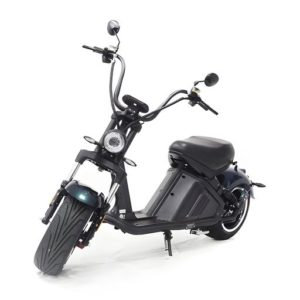
Practical Applications
Urban Commuting: One practical application of artificial intelligence (AI) in urban commuting is the optimization of traffic flow and congestion management. AI algorithms can analyze real-time traffic data from various sources such as sensors, GPS devices, and traffic cameras to identify patterns and make predictions. This information can be used to optimize traffic signal timings, reroute vehicles, and suggest alternative transportation modes to reduce congestion and improve commuting times.
Additionally, AI-powered ride-sharing platforms have transformed urban commuting. These platforms use AI algorithms to match riders with drivers efficiently, considering factors such as location, destination, and driver availability. This not only reduces individual car usage but also enables more efficient use of existing transportation infrastructure.
Campus and Neighborhood Travel: AI can be applied to optimize transportation within campuses and neighborhoods. For example, autonomous shuttles or robots equipped with AI can be deployed to transport students or residents within a campus or neighborhood. These vehicles can navigate through predefined routes, avoiding obstacles and adapting to real-time traffic conditions.
Furthermore, AI can assist in providing real-time information on shuttle schedules, parking availability, and transportation options within a campus or neighborhood. This information can be accessible through mobile applications or smart kiosks, allowing users to plan their journeys more efficiently.
Tourism and Sightseeing: AI can enhance the tourism and sightseeing experience in various ways. Natural language processing (NLP) algorithms can be employed to develop AI-powered virtual tour guides or chatbots. These guides can provide visitors with information about historical landmarks, cultural sites, and popular attractions, answering their questions and offering personalized recommendations based on their preferences.
Computer vision algorithms can also be utilized to enhance augmented reality (AR) experiences for tourists. By analyzing the camera feed from a smartphone or AR glasses, AI can overlay relevant information, historical context, or interactive elements onto the user’s view, enriching their exploration of a destination.
Delivery Services: AI has revolutionized the delivery services industry. Delivery companies are leveraging AI algorithms to optimize delivery routes, predict delivery times accurately, and allocate resources efficiently. By considering factors like traffic conditions, delivery volume, and customer preferences, AI can suggest the most efficient routes and enable companies to provide reliable and timely deliveries.
Moreover, autonomous delivery vehicles are being developed and deployed in certain areas. These vehicles, equipped with AI, can navigate through streets, avoid obstacles, and deliver packages to customers’ doorsteps autonomously. AI algorithms also play a crucial role in coordinating the operations of a fleet of autonomous vehicles, ensuring seamless delivery processes.
Senior Mobility Solutions: AI-based solutions are increasingly being developed to address the mobility challenges faced by seniors. Intelligent transportation systems can assist in improving the accessibility and safety of transportation options for older adults. AI algorithms can analyze data from various sources, including sensors and smart devices, to identify potential hazards or risks and provide real-time alerts or assistance.
Moreover, AI-powered virtual assistants can help seniors with trip planning, providing information about public transportation options, accessible routes, and schedules. These assistants can also integrate with wearable devices or smart home systems to monitor seniors’ health conditions during their journeys, ensuring their well-being.
Artificial intelligence is finding practical applications in various aspects of transportation and mobility. From optimizing traffic flow and enabling efficient urban commuting to enhancing tourism experiences and addressing specific mobility needs, AI is revolutionizing how we move and navigate our surroundings. With further advancements and integration with emerging technologies, AI will continue to play a significant role in shaping the future of transportation.
Market Growth and Demand
The market for artificial intelligence (AI) in transportation and mobility is experiencing significant growth and is expected to continue expanding in the coming years. Factors driving this growth include the increasing need for efficient transportation solutions, rising urbanization, and advancements in AI technology.
The demand for AI in transportation is fueled by the need for optimizing traffic flow, reducing congestion, and improving commuting times in urban areas. Additionally, the rise of ride-sharing platforms, autonomous vehicles, and delivery services has further increased the demand for AI solutions in transportation and mobility.
The market is also driven by the growing adoption of AI-powered virtual assistants and chatbots in the tourism and travel industry. These AI systems provide personalized recommendations, enhance the sightseeing experience, and cater to the preferences of tourists. autonomous vehicle technology, and transportation companies are collaborating with AI startups to enhance their services and improve operational efficiency.
Competitive Landscape
The competitive landscape in the AI transportation and mobility market is characterized by the presence of both established technology companies and startups. Major players include technology giants such as Google (Waymo), Uber, Tesla, and Amazon, as well as traditional automakers and transportation companies that are investing in AI technologies.
Startups are also making significant contributions to the market, focusing on areas such as autonomous vehicle technology, smart mobility solutions, and AI-powered analytics platforms. These startups often bring innovative approaches and niche expertise, challenging established players and driving further competition.
Partnerships and collaborations between different companies are also common in this market. Automakers are partnering with tech companies to develop autonomous vehicle technology, and transportation companies are collaborating with AI startups to enhance their services and improve operational efficiency.
Technological Advancements
Technological advancements in AI are key drivers of the market growth. Machine learning algorithms, deep learning techniques, and computer vision systems are continually evolving, enabling more sophisticated applications in transportation and mobility.
Advancements in sensor technologies, such as LiDAR and radar, have improved the perception capabilities of autonomous vehicles, enhancing their ability to navigate complex environments and ensure passenger and pedestrian safety.
Furthermore, the development of edge computing and the deployment of 5G networks have facilitated real-time data processing and communication, enabling faster and more efficient AI-powered transportation systems.
Regulatory Considerations
As AI technologies become more prevalent in transportation and mobility, regulatory considerations play a crucial role in shaping the market. Governments and regulatory bodies are addressing concerns related to safety, privacy, and ethical use of AI in transportation.
Regulations for autonomous vehicles are being developed to ensure the safe deployment and operation of self-driving cars on public roads. Governments are also working on data protection and privacy regulations to safeguard the personal information collected by AI systems in transportation.
Moreover, ethical considerations such as bias and transparency are being addressed to ensure that AI systems in transportation and mobility are fair, accountable, and transparent in their decision-making processes.
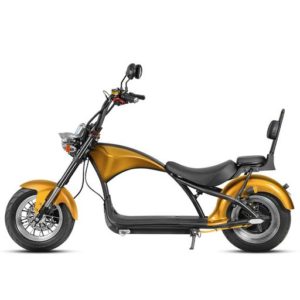
Future Trends and Innovations
The future of AI in transportation and mobility holds several exciting trends and innovations. Some key areas to watch for include:
- Increased adoption of autonomous vehicles: Autonomous vehicles are expected to become more widespread, revolutionizing the transportation industry. The deployment of self-driving cars and trucks is anticipated to reduce accidents, improve traffic flow, and enhance overall transportation efficiency.
- Integration of AI with Internet of Things (IoT): AI algorithms will be integrated with IoT devices to create smarter transportation systems. This integration will enable real-time monitoring of traffic conditions, infrastructure maintenance, and predictive maintenance of vehicles, leading to more efficient and sustainable transportation networks.
- Enhanced multimodal transportation solutions: AI will play a crucial role in developing integrated multimodal transportation solutions. AI algorithms will optimize the combination of different transportation modes such as public transit, ride-sharing, and micro-mobility options to provide seamless and personalized journeys.
- Advancements in natural language processing: Natural language processing will continue to improve, enabling more sophisticated AI-powered virtual assistants and chatbots. These assistants will provide real-time information, personalized recommendations, and interactive experiences, enhancing the overall travel and tourism experience.
- Sustainability and environmental considerations: AI will contribute to the development of greener and more sustainable transportation solutions. By optimizing routes, managing energy consumption, and promoting shared mobility, AI can help reduce carbon emissions and mitigate the environmental impact of transportation.
As personal transportation undergoes a rapid transformation, electric scooters with seats have emerged as a practical and versatile solution. By combining the best aspects of traditional scooters and comfortable seating, these innovative vehicles offer an enhanced riding experience, improved stability, and extended range. Moreover, they contribute to reducing carbon emissions and alleviating traffic congestion in urban areas. With the growing demand for eco-friendly transportation options, electric scooters with seats are poised to play a pivotal role in shaping the future of personal mobility. As technology advances and regulatory frameworks adapt to these evolving trends, we can expect to see further refinements and innovations in this exciting field. The era of electric scooters with seats has arrived, promising a greener, more efficient, and more comfortable way to navigate our cities.
WARNING:

Before you go Enter the Draw for the Bugatti Electric Scooter Draw Here:
Ebikes Worth Mentioning Click Here
Back to Top
To use our purchasing process you must be 18 years of age or older to purchase any product on our website and not represent or purchase on behalf of anyone under this age as set at the point of purchase. The scooter will be registered on our database to the Name and Address etc of the purchaser.
This post or page may contain affiliate links that may earn a small commission at no additional cost to you. I use affiliate links because they allow me to share useful products and services with you that are related to the topic of my website. Affiliate links also help me earn some income from my website, which enables me to keep creating high-quality content for you. I appreciate your support and trust!
Gas Powered Scooter For Adults With Seat – Assembly
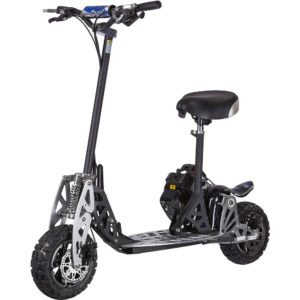
1. Assembly Instructions
The majority of the scooter is going to be assembled. It’ll be folded like this in the box. All you have to do is basically bolt on the handlebars. Remember to tighten all Nuts, Bolts, and Screws in case they have loosened in transit.

2. Handlebars Assembly
So, first, I’m going to show you there’s a lever here that you will pull down, and this will allow you to pivot the handlebars up, and you’ll notice those will lock into place. And then you will set the handlebars onto the post here, position them straight with the front wheel, and then there’s simply two Allen bolts, so make sure you get these nice and tight so your handlebars can’t spin on you.
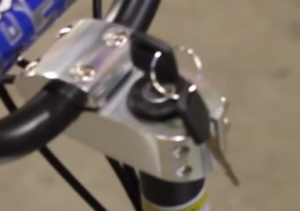
3. Seat Installation
Next, let’s take a look at the seat. This does come with a quick-lock seat, so you will remove the finger bolt here, you’ll open this up, and you’ll just simply slide this into the deck, pull this back, it’ll latch the front here, and then tighten down the bolt to secure. Now, of course, this seat is optional; you can stand up or have it attached.
4. Brake Lever and Throttle Adjustment
We have front and rear brake levers. We like to adjust these to be horizontal and right below that. This is actually the finger throttle. We like to tilt this one just slightly down for writing. To have these really close, basically.
5. Key and Ignition Functionality
You have your on and off key. Now, the way the key works is this is just a kill switch. So when the key is off, that actually shorts out the spark plug on the motor, so you can’t start it. So, if the scooter will not fire up for you, definitely make sure you have your key on.
6. Shifter and Gear Selection
On the left side here, we have the shifter. Now, if you take a look, we have a low and a high. When you push the bottom lever, it’s going to push in hard because it has to pull stiff on the cable. And then you let go, and it’s actually going to click and hold. And now the indicators are in the middle of the window. We never push this over too high, even though the shifter can be shifted twice and the indicator can move over. It’s really only meant to be pushed once. Now we’re in second gear when you’re driving. Simply push the top one. That’ll release us back to first gear. Now, you don’t have to let off the gas to shift. You can just push and shift whenever you want.
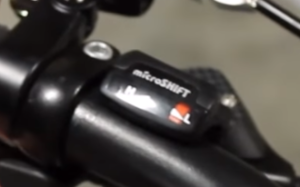
7. Brake Caliper Adjustment
About adjusting the brakes, these brake calipers are a little bit different than your standard scooter. If you need to get more adjustment on the scooter, this is the lever that pulls inward when you pull the brake cable. You can simply loosen the bolt that squeezes the cable, pull the cable through a little bit more, retighten it, and that’ll tighten up your brake. You can also adjust on the brake levers just like on a bicycle. You can adjust the tension of the cable there as well.

8. Wheel Inspection and Maintenance
Obviously, once the pads wear down, you just buy new pads and replace them. Another thing, both wheels should spin freely like this, where the pads are not rubbing on the disk. This one’s just a little different than the standard caliper. These two bolts that hold it, these Allen bolts, you loosen those. Now, you can slide the caliper in and out to make sure you center the pads around the disk so there’s no friction there and make sure the wheel spins smoothly.
9. Folding and Carrying the Scooter
Now, just to fold the scooter down, just like we put it up, you’ll pull this lever back. One important thing to note is make sure you have a hand on the top of the handlebar when you pull this down. Otherwise, this can drift down and hit you in the head. What’s nice is when it locks back down, you can actually grab the handle of our post and carry this handle.
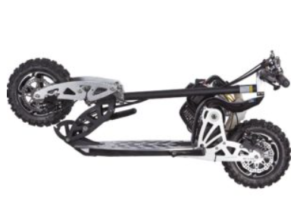
10. Starting the Scooter
Starting the scooter, this is a two-stroke engine, so that means you have to mix gas with the oil. If you run straight gas, the motor will last just and you’ll need to replace the motor. To mix your gas and oil, you will get a mixing container. We recommend mixing at a 32:1 ratio. If you look on the container here, here’s how to use it. You’re going to fill the tank up with gas up to the 1100 mark, which is basically the second notch down, and then you’re going to pour two-stroke oil until it reaches the top line. And then simply shake it up, pour it into your gas tank. Now, you can premix one 2.5-gallon gas tank in your garage. Just mix four ounces of oil per one gallon of gas. That way, you can just keep filling up and you don’t have to mix the tank each time.
11. Fuel Mixture and Gas-Oil Ratio
To mix the gas and oil, use a 32:1 ratio… 32 parts gas to 1 part 2 stroke oil.
12. Priming and Choke Operation
To start the scooter, make sure the key is on. Take a look here, just like any two-stroke motor, like a quad or a dirt bike or a chainsaw, you’re going to want to push the primer bulb. So the primer bulb is underneath the carburetor. You’re going to want to push this at least six times, or until you can see all the gas flowing through the lines. If you don’t do this, it’s going to take forever to start because there’s no fuel in the carburetor. And, of course, if you can’t get any gas up, make sure you have enough gas in your tank. Sometimes the gas line does not reach to the very bottom of the tank.
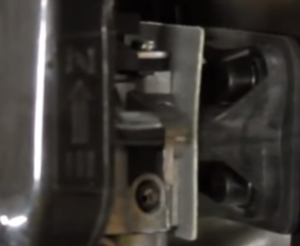
13. Air Filter Maintenance
Under here is the air filter. You can just simply remove this finger screw, pull off the cover, and you have your air filter there if you ever want to check it. If you’re riding in dusty areas and you need to clean it.
14. Pull Start Tips
A few things about the pull start. If you’re rough with these pull starts, they will break very quickly. So, there are a few things to know. When you grab the pull start handle, we like to pull out slow just like this until it grabs the engine. And now we’ll make our starting pull. If you don’t do that and you just start pulling really hard, it jerks against the engine, the pull start’s going to break a lot quicker. Another thing, don’t pull this handle out too far. It should only need to come out about a foot. If you start going further, you’re going to get to the end of the rope and it’s going to break in at the inside off. And same thing when you pull it out, don’t ever let it slap back in like that. Don’t ever let it go because that can make the spring pop off. So just try to let it back in by hand.

15. Carburetor Adjustment
Now, if your engine is not running well, if the gas doesn’t want to go, seems like it’s bogging down, then you’re going to want to adjust the fuel mixture screw on the engine. Now, we’re going to show you this at the end of the video. We’ll fire it up, we’ll show you how that works and how to adjust it.

16. Chain Adjustment Bolt Under Deck
Now, we’re going to show you how to adjust the chain and the belts. So, on most scooters on the market, the rear axle can actually be adjusted forward and back to tighten the chain. On this model, the axle is solid in the back, and there’s going to be this one tension bolt underneath the bottom of the scooter here. You can see it. So how this works is when you tighten this bolt, it’s going to pivot this arm forward, which moves the gearbox forward, hence tightening the chain. So you’ll see there’s also a locking nut here. So first, you loosen the locking nut, tighten in the Allen bolt, and then tighten the locking nut back up. Now, you don’t want to make the chain too tight. It should just be lightly snug. It will stretch over time. Once it stretches too much, you’ll notice it’ll start to eat away the teeth on your sprocket. That’s definitely time to get a new chain and replace that.
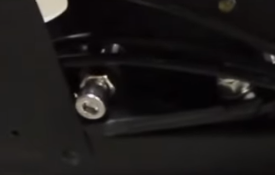
17. Belt Adjustment
Next, we’re going to talk about the belts because this is a two-speed scooter. We have two belts, one belt for first gear, one belt for second gear. The rear fender just simply pops off. Something new the factory added was this cover around the belt drives. I personally like to take the cover off and leave it off. That way, you can see when the belts stretch and when they need to be adjusted, and the cover has to be off to adjust those as well. So I’m going to take this cover off. We’ll write back a few moments later.
Alright, so now we’re going to show you how to adjust the belts. So, just like the chain, the belts will also stretch over time and need to be adjusted. We recommend keeping up on the belts. If you let the belts get too loose, they will actually skip on these pulleys and they will snap and break. And then it’s a lot harder to replace the belts than it is the chain.
So first things first, on the left belt, on the upper side of this, you’ll see this little short bolt going through here. So, you’re going to want to loosen this bolt, and then you’re going to take something like an extra tool, a screwdriver, and you’re going to wedge this horizontal upward. And you’ll see with these plastic pieces, it’s going to pivot this whole top shaft up, which is going to tighten both belts. Try to keep this horizontal rod basically straight across and horizontal. If you have the left or the right up too high or twist it to try to get one belt tighter than the other, that will make things wear out, especially the bearings. So try to keep it straight. One belt will sometimes be tighter than the other. That’s normal just because you’ll drive usually in second gear more than you do in first.
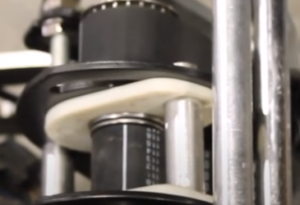
Next, let’s take a look at where the two-speed shifter connects to the bottom. So if you look, this cable is coming from your thumb shifter on the left hand, and it comes out. It’s going to wrap around this black disc, and then go back to a solid bolt where it’s squeezed. So when you do shift into second gear, you can see this cable is going to pull this black arm. Now, this black arm pushes this pressure plate into the side of some clutch pads that are on the inside of this pulley. Once those clutch pads are squeezed and held, that’s actually going to make the gearbox switch over to the second-speed belt, and then that’s going to put you in a second gear. And then, of course, when you release the shifter, this arm is going to bend over, takes pressure off the pressure plate, and then go back to the first belt and have you back in first gear.
Now, if you ever give it gas when you’re in second gear and it seems like it slips, that usually means the clutch pads in here slipping. Either this arm is not tight enough, which you would just want to tighten this cable, or those clutch pads inside have worn down and you need to replace them. So it’s always important as this cable stretches to when you’re shifting into second gear, if this is not tight, come back and tighten that. You can see we got this bolt here. You can adjust this. We’ll tighten it. If you can’t get enough adjustment, then where the end of the cable attaches, just like it does on a brake, you’ll loosen that bolt, pull the cable through more, and retighten it.
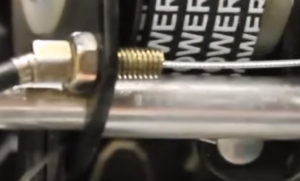
18. Kill Switch and Spark Plug Check
Now, if you have any problems starting the scooter, let’s take a look here. You’ll see these two wires coming on the top of the motor. These are the kill switch wires. These actually come from the key. So sometimes this key wire can get shorted between the frame, and then, of course, you get no spark and you can’t start it. So if you disconnect this connector, that’ll actually bypass the key. Then see if the scooter will fire up. If it does, then you know that the key switch or the key wire is the problem.
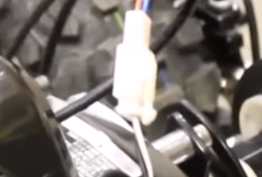
Another thing to check is the top of the spark plug cable. Pop this off. Make sure the metal end is in there. Make sure it’s pushed all the way down so you’re getting spark. If you need to check for spark, pull this cover off. Remove the spark plug. Plug it back into the cap, and then just let the top of the spark plug rest on the top of the motor. Then pull the pull start, and you should see a spark. Of course, make sure the key is on or the kill switch is disconnected. If you don’t see a spark, then generally, the ignition coil is bad, and you can replace the ignition coil. Or it could be a bad plug as well.
19. Fuel Mixture Screw Adjustment
If you let the scooter sit for a long time, you may need to replace the carburetor as well. But generally, the carburetor just needs to be adjusted. If you can’t even get the scooter started enough to adjust the carb screw, that fuel mixture screw on the side, then we can just try to set it back to default, and then you can at least get it running, and then you can adjust it from there. So just take the screw with your special tool, Pacman tool, the new one uses this tool, a circle with a dot in it. So you’ll need to get this tool, and what you can do is turn the fuel mixture screw all the way into the right until the screw stops, and then back it out to one and three-quarters of a turn. And that should be enough to get you started, and then you can adjust from there
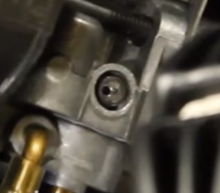
20. Engine RPM Optimization
So next, we’ll move this outside, fire it up, and I’ll show you how to adjust the fuel mixture screw. Now, before we adjust the fuel mixture screw and explain what we’re doing, once I fire the engine, you won’t be able to hear me. We’ll get the motor started, warmed up, and then what we’re going to do is we’re going to hold the throttle wide open, and then we’re going to adjust the screw. So before we do that, we always like to put this scooter in second gear. We found that the fuel mixture screw adjusts a little bit better when the engine is under a load. So we always like to put it in second gear. That will make it a little harder to spin the wheel so we get a better adjustment.
Now, the idea is once it’s running and it’s wide open, we’re going to start turning this fuel mixture screw counterclockwise, which is outward. And we want to slowly go outward until the engine’s RPM starts to slow down and the engine starts to run boggy. That means we’re running too rich, and that’s kind of where we want to start. Once we know that, we can tell it’s running boggy, then we’re going to slowly turn the fuel mixture screw inward, which is going to make the engine run more lean. And the idea is to just slowly keep turning it until you reach max RPM. You don’t want to go past that point because then you’ll run the engine too lean. It’ll get too hot and can wreck the motor.
So what I’ll do is I’ll do it a few times. I’ll take it down to a boggy state. We’ll slowly go up until we hit full RPM. And if you go too far, then the engine will actually slow down and want to cut out too if it’s too lean. So I’ll do it a few times. You can kind of see right where we set it. And this is the best way to tweak it. The engine will take three to four full tanks of gas to be fully broken in, so you may have to adjust it again to get top speed out of it. But here we go.
There you go. You can see we turned it outward, we definitely lowered the RPMs, made the engine run boggy. We turned it up, make it lean, to where we got max RPM. You may have to play with that a few times. You may have to turn it inward a little too far to know that here at the highest RPMs when it starts to run bad, and then go back to rich again and start.
WARNING:

Before you go Enter the Draw for the Bugatti Electric Scooter Draw Here:
Ebikes Worth Mentioning Click Here
Back to Top
To use our purchasing process you must be 18 years of age or older to purchase any product on our website and not represent or purchase on behalf of anyone under this age as set at the point of purchase. The scooter will be registered on our database to the Name and Address etc of the purchaser.
This post or page may contain affiliate links that may earn a small commission at no additional cost to you. I use affiliate links because they allow me to share useful products and services with you that are related to the topic of my website. Affiliate links also help me earn some income from my website, which enables me to keep creating high-quality content for you. I appreciate your support and trust!
Recent Posts
- Health Benefits of Electric Bikes
- What to Look for When Buying an E-bike
- Best Electric eBikes for Your Little One
- How to Safely Unlock the Top Speed on Unagi Electric Scooters
- Breaking: The Shocking Truth About E Scooter Laws in WA!
- Can You Ride Scooters On The Road “California”
- Can Electric Scooters Get Wet? Yes!
- How do I transport my electric scooter in a car?
- Top 6 Long Range Electric Scooters
- Two-Stroke or Four-Stroke? Gas Scooter Showdown
